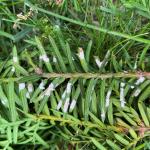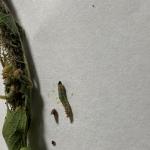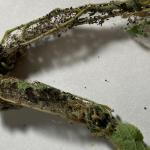UMass Extension's Landscape Message is an educational newsletter intended to inform and guide Massachusetts Green Industry professionals in the management of our collective landscape. Detailed reports from scouts and Extension specialists on growing conditions, pest activity, and cultural practices for the management of woody ornamentals, trees, and turf are regular features. The following issue has been updated to provide timely management information and the latest regional news and environmental data.
The Landscape Message will be updated weekly in June. The next message will be posted on June 18. To receive immediate notification when the next Landscape Message update is posted, be sure to join our e-mail list
To read individual sections of the message, click on the section headings below to expand the content:
Scouting Information by Region
Environmental Data
The following data was collected on or about June 9, 2021. Total accumulated growing degree days (GDD) represent the heating units above a 50° F baseline temperature collected via regional NEWA stations for the 2021 calendar year. This information is intended for use as a guide for monitoring the developmental stages of pests in your location and planning management strategies accordingly.
|
MA Region/Location |
GDD |
Soil Temp |
Precipitation |
Time/Date of Readings |
||
|
1-Week Gain |
2021 Total |
Sun |
Shade |
|||
|
CAPE |
149.5 |
446 |
69 |
65 |
0.28 |
12:00 PM 6/9 |
|
SOUTHEAST |
162.5 |
498.5 |
84 |
72 |
0.24 |
4:00 PM 6/9 |
|
NORTH SHORE |
189 |
591.5 |
72 |
68 |
0.13 |
10:30 AM 6/9 |
|
EAST |
185 |
593.5 |
73 |
67 |
0.12 |
4:00 PM 6/9 |
|
METRO |
173 |
556 |
70 |
65 |
0.008 |
5:30 AM 6/9 |
|
CENTRAL |
179.5 |
576 |
70 |
70 |
0.11 |
7:00 AM 6/9 |
|
PIONEER VALLEY |
176 |
568 |
73 |
69 |
0.48 |
12:00 PM 6/9 |
|
BERKSHIRES |
150.5 |
428 |
68 |
66 |
0.42 |
8:00 AM 6/9 |
|
AVERAGE |
171 |
532 |
72 |
68 |
0.22 |
_ |
|
n/a = information not available |
||||||
As of 6/8, there is a status of "abnormally dry" for the Cape and Islands: https://droughtmonitor.unl.edu/CurrentMap/StateDroughtMonitor.aspx?MA
Current municipal water restrictions are shown on this map: https://www.mass.gov/doc/water-use-restrictions-map/download
Phenology
| Indicator Plants - Stages of Flowering (BEGIN, BEGIN/FULL, FULL, FULL/END, END) | ||||||||
|---|---|---|---|---|---|---|---|---|
| PLANT NAME (Botanic/ Common) | CAPE | S.E. | N.S. | EAST | METRO W. | CENT. | P.V. | BERK. |
|
Tilia cordata (littleleaf linden) |
Begin |
* |
* |
Begin |
Begin |
* |
Begin |
* |
|
Rhus typhina (staghorn sumac) |
* |
* |
* |
* |
* |
* |
* |
* |
|
Ligustrum spp. (privet) |
Begin |
Begin |
Begin |
Begin |
Begin |
* |
Begin |
* |
|
Catalpa speciosa (northern catalpa) |
Begin |
Begin |
Begin |
Begin |
Begin |
Begin |
Begin/Full |
* |
|
Kalmia latifolia (mountain laurel) |
Begin/Full |
Full |
Full |
Full |
Full |
Full |
Full |
* |
|
Cotinus coggygria (common smokebush) |
Begin/Full |
Begin/Full |
Full |
Full/End |
Full/End |
Begin/Full |
Full |
Full |
|
Weigela florida (old fashioned weigela) |
Full/End |
Full/End |
Full/End |
Full/End |
Full/End |
Full/End |
End |
Full/End |
|
Syringa meyeri (Meyer lilac) |
End |
Full |
Full/End |
Full/End |
Full/End |
* |
Full/End |
Full |
|
Enkianthus campanulatus (redvein enkianthus) |
* |
* |
End |
Full/End |
End |
Full/End |
End |
Full |
|
Rhododendron catawbiense (catawba rhododendron) |
Full/End |
Full/End |
End |
Full/End |
Full/End |
Full/End |
Full/End |
Full/End |
|
Robinia pseudoacacia (black locust) |
End |
End |
End |
End |
End |
End |
End |
End |
| * = no activity to report/information not available | ||||||||
Regional Notes
Cape Cod Region (Barnstable)
General Conditions: The average temperature for the period from June 2 – June 9 was 70˚F with a low of 55˚F on June 3rd and a high of 90˚F on June 6. June 5 through June 9 has been dominated by higher than normal temperatures with a 5 day stretch (so far) of highs in the 80s and lows in the upper 60s. A little precipitation occurred on June 2 and June 3 totaling about a quarter of an inch. Soil moisture remains adequate following the previous periods’ precipitation, but may be short lived without more consistent precipitation events. The hot conditions have caused stress to newly planted trees, shrubs and herbaceous plants resulting in a need for increased watering frequency. Herbaceous plants seen in bloom during the period include lupine, foxglove, peony, bearded iris, Japanese iris, blood red geranium, oxeye daisy, painted daisy, fringed bleeding heart, blue false indigo, catmint, salvia, goat’s beard, lady’s mantle, and amsonia. Woody plants seen in bloom during the period include arrowwood viburnum, alternate leaf dogwood, kousa dogwood (in full bloom), roses, ninebark, yellowwood, Japanese snowbell, tree lilac, tulip tree and clematis.
Pests/Problems: Insect pests or insect damage seen during the period include oak shothole leafminer damage on white oak in the upper Cape region, lecanium scale on oaks in the mid Cape area (female adults are now hemispherical in shape and can be found with eggs underneath), black turpentine beetle damage on pitch pine, viburnum leaf beetle larvae on viburnum, azalea lacebug nymphs on PJM rhododendron, andromeda lacebug on andromeda, earwig damage to buddleia, and aphids on numerous herbaceous and woody species. Disease symptoms or signs during the period include needle cast on the previous seasons’ needles of pitch pine, white pine decline symptoms, red thread on turf and cercospora leaf spot on oak leaf hydrangea. Invasive plants and weeds seen in bloom include multiflora rose, black swallow-wort, black medic, yellow wood sorrel, red sorrel, and narrowleaf plantain.
Southeast Region (Dighton)
General Conditions: Temperatures in the nineties have made it challenging to work outdoors without being fully acclimated. I'm all the more thankful for the rain of the previous week. Among the many plants I've noticed in flower are the following: Achillea millefolium (common yarrow), A. 'Moonshine', Agastache (hyssop), Allium spp.(flowering onion), Aquilegia (columbine), Astilbe (false goat's beard), Baptisia australis (false blue indigo), Catalpa speciosa (catawba-tree), Coreopsis spp.(tickseed), Chionanthus virginicus (white fringetree), Clematis 'Jackmanii', Cotinus coggygria 'Royal Purple' (royal purple smokebush), Cornus kousa (Chinese dogwood), Cytisus scoparius (Scotch broom), Dianthus spp.(pinks), Dicentra formosa (western bleeding heart), Digitalis purpurea (biennial foxglove), D. lutea (perennial foxglove), Echinacea purpurea (purple coneflower), Erigeron annuus (annual fleabane), Geranium sanguineum (bloody geranium), Hemerocallis 'Stella D’Oro' (reblooming daylily), Hypericum perforatum (St. John's-wort), Iris germanica (German iris), I. pseudacorus (yellow flag iris), I. sibirica (Siberian iris), Kalmia latifolia (mountain laurel), Leucanthemum vulgare (oxeye daisy), L. x superbum (shasta daisy), Leymus arenarius (lyme grass), Ligustrum (privet), Lilium (true lilies), Linaria vulgaris (common toadflax), Linnaea amabilis (Kolkwitzia, beauty bush), Lonicera japonica (Japanese honeysuckle), L. sempervirens (trumpet honeysuckle), Lupinus (lupine), Lysimachia vulgaris (yellow loosestrife), Medicago lupulina (black medic), Nepeta spp.(catmint), Oenothera biennis (evening primrose), Paeonia officinalis (garden peony), Papaver orientale (oriental poppy), Physocarpus (ninebark), Pilosella (hawkweed), Plantago lanceolata (buck's-horn plantain), Rosa multiflora (multiflora rose), R. virginiana (Virginia rose), R. 'Knockout', Rhododendron x catawbiense, Salvia (sage), Sambucus canadensis (elderberry), Sedum stenopetalum (yellow stonecrop), Stachys byzantina (lamb's ear), Syringa meyeri (Meyer lilac), S. reticulata (tree lilac), Trifolium pratense (red clover), T. repens (white clover), Vicia (vetch), Viburnum plicatum (Japanese snowball, doublefile viburnum), V. dentatum (arrowwood viburnum), Viola tricolor (wild pansy) and Weigela.
Pests/Problems: Copious quantities of windblown grass pollen are everywhere, making for itchy eyes. Both swamp red maples and silver maples appear to have had a "mast" seed set this year. Some swamp red maples have virtually all of their resources invested in samaras and only a few terminal leaves. Such a reproductive strategy may help them to overwhelm the organisms that feed on maple samara. Red Thread was seen on a lawn. I've found that improper irrigation is a common cause of problems on residential turf. Somehow the default setting on many systems appears to be 15 minutes per zone daily. We should be watering deeply but only infrequently. Typical recommendations are one inch of water, or approximately 623 gallons, per one thousand square feet per week over only two or three applications.
North Shore (Beverly)
General Conditions: During this reporting period we had the first heat wave of 2021 with temperatures above 90℉ recorded for three consecutive days on June 6, 7 and 8. The average daily temperature was 77℉ with the maximum temperature of 94℉ recorded on June 8 and the minimum temperature of 60℉ recorded on June 3. Very little precipitation was received in the area during this period. Only 0.13 inches of rainfall was recorded at Long Hill during this period. Woody plants seen in bloom include: Kousa dogwood (Cornus kousa), arrowwood viburnum (Viburnum dentatum), fringe tree (Chionanthus virginicus), beautybush (Kolkwitzia amabilis), mountain laurel (Kalmia latifolia), weigela (Weigela florida), Japanese snow bell (Styrax japonicus), upright stewartia (Stewartia rostrata) and Chinese stewartia (Stewartia sinensis). Non-woody plants seen in bloom include: peony (Paeonia spp.), cranesbill (Geranium spp.), redleaf rose (Rosa glauca), fingerleaf rodgersia/Rodger’s flower (Rodgersia aesculifolia), goat’s beard (Aruncus dioicus), water lily (Nymphaea odorata) and several annuals.
Pests/Problems: Cottony taxus scale (also known as cottony camellia scale), Pulvinaria floccifera, was observed on some yew bushes. Web-spinning sawflies, likely in the genus Neurotoma, were observed on beach plum (Prunus maritima). Sawfly caterpillars in this genus feed on cherry, plum, peach, almond, and hawthorn. At least five species in this genus are known to North America. These sawflies feed together in groups, webbing together leaves as they feed. Fungal leaf spot was observed on mountain laurel. Multiflora rose (Rosa multiflora) and roseleaf bramble (Rubus rosifolius) weeds are in full bloom and are easy to identify. Ticks and mosquitoes are very active. Make sure you protect yourself with appropriate repellents before you go out into areas with vegetation.
East Region (Boston)
General Conditions: It has been a spring of extremes. Following the wet and cold end of May, we experienced our first heat wave of the season as June 6th through the 9th were in the 90’s. We received 0.12 inches of insignificant precipitation. Cornus kousa (Kousa dogwood) and Kalmia latifolia (mountain laurel) are in full bloom.
Pests/Problems: Vulnerable plants are suffering stress from the extreme weather conditions. Vegetable gardens are struggling to adjust to fluctuating temperatures. Cottony Taxus scale (Pulvinaria floccifera) has been seen on Taxus spp. (yew) and Ilex spp. (holly). The bright orange alien looking masses of Cedar Apple Rust (Gymnosporangium juniperi-virginianae) spores have been seen on junipers.
Metro West (Acton)
General Conditions: The first day of summer is more than a week away, yet we have experienced August-like temperatures with our first heat wave of the season this past week. It began on the 5th and continued through to the 8th with high temperatures of 90°, 91°, 94° and 93° (Fahrenheit) recorded, respectively. The historical monthly average rainfall for June is 3.93” and a meager 0.008” of rain has been recorded for this month so far. Observed in some stage of bloom this past week were the following woody plants: Buddleia spp. (butterfly-bush), Calycanthus floridus (Carolina allspice), Catalpa speciosa (northern catalpa), Chionanthus retusus (Chinese fringetree), C. virginicus (American fringetree), Cornus kousa (Kousa dogwood), Cornus sericea (redosier dogwood), Cotinus coggygria (smoketree), Deutzia sp. (deutzia), Kalmia latifolia (mountain laurel), Kolkwitzia amabilis (beautybush), Leucothoe axillaris (coast leucothoe), Ligustrum spp. (privet), Liriodendron tulipifera (tulip tree), Philadelphus sp. (sweet mock orange), Physocarpus opulifolius (common ninebark), P. opulifolius 'Summer Wine' (summer wine ninebark), Potentilla fruiticosa (potentilla), Rhododendron spp. (rhododendron and azalea), Rosa gallica (French rose), R. glauca (shrub rose), R. 'Knockout' (knockout family of roses), Rosa rugosa (beach rose), Rosa spp. (rose), Sambucus canadensis (elderberry), Spiraea japonica 'Alpina' (daphne spirea), S. prunifolia (bridal wreath), Styrax japonicus (Japanese snowbell), Syringa reticulata (Japanese tree lilac), Tilia cordata (littleleaf linden) and Weigela florida (old fashioned weigela). Woody vines observed in bloom include Clematis spp. (Clematis), Hydrangea anomala petiolaris (climbing Hydrangea), Lonicera sempervirens (trumpet honeysuckle) and Wisteria spp.
Contributing even more color and interest to the landscape are some flowering herbaceous plants including: Achillea millefolium (yarrow), Alchemilla mollis (lady's mantle), Allium spp. (ornamental flowering onion) - including A. giganteum (giant onion) and A. schoenoprasum (chives), Aruncus aethusifolius (dwarf goat’s beard), A. dioicus (goat’s beard), Baptisia australis (false blue indigo), Campanula takesimana ‘Elizabeth’ (bell flower), C. spp. (bell flower), Chrysogonum virginianum (green and gold), Clematis recta 'Purpurea' (clematis), Dianthus deltoides (maiden pink), Dicentra eximia (fringed bleeding heart), Dictamnus albus (gas plant), Digitalis purpurea (foxglove), Filipendula spp. (meadow sweet), Geranium cantabrigiense 'Biokovo' and 'Cambridge' (hardy cranesbill), Geranium maculatum (wild geranium), G. macrorrhizum (bigroot geranium), G. sanguineum (bloody cranesbill), Hemerocallis 'Stella D'Oro' (daylily), Hemerocallis spp. (daylily), Iris germanica (bearded iris), I. sibirica (Siberian iris), I. versicolor (blue flag iris), Lupinus 'Russell Woodfield Hybrids' (lupine), Maianthemum racemosum (false Solomon seal), Nepeta spp. (ornamental catmint), Paeonia spp. (peony), Penstemon digitalis 'Husker Red' (beardtongue), Phlox divaricata (Canadian phlox), Primula spp. (primrose), Salvia nemerosa (salvia), Sedum kamtschaticum (Russian stonecrop), Thymus praecox (thyme), Tradescantia spp. (spiderwort), and Veronica umbrosa 'Georgia Blue' (speedwell).
Pests/Problems: Rosa multiflora, an aggressive and invasive vine, is just coming into bloom and is very easy to detect with its abundant white flowers seen growing in and amongst other trees and shrubs in the planted and/or wild landscape.
Central Region (Boylston)
General Conditions: After the past week, many of us are ready for summer to end already. The heat and humidity were oppressive, but thankfully the 6 inches of rain we received the previous week helped to mitigate drought stress. Garden soils are still holding moisture without much additional precipitation during this reporting period. Much is in bloom throughout the garden. Mountain laurel (Kalmia latifolia) is just coming into bloom. This native broadleaf evergreen shrub is common and widespread in forests across New England. The uncultivated natural species typically features white to pink flowers in early summer. There are dozens of cultivars, many of which feature exquisite flowers from white to deep red and interesting mottling or striping. In the wild, mountain laurel can reach heights of 15 to 20 feet. In cultivation, dwarf cultivars that top out at 3 or 4 feet are available for smaller gardens.
Pests/Problems: Eriophyid mites were observed causing erineum galls on river birch (Betula nigra). This arachnid does not necessarily cause undue stress or damage to river birch, but creates what looks like a fuzzy red velvet on impacted leaf surfaces.
Pioneer Valley Region (Amherst)
General Conditions: Hot and humid conditions ruled this past reporting period as the summer’s first heat wave took place from 6/5 through 6/9. Temperatures peaked on 6/7 with high of 95°F and an overnight low of 70°F on 6/8. Numerous high temperature records were met or exceeded across the northeast, according to the NWS Eastern Region HQ. During the early afternoon hours on 6/8, strong but slow-moving thunderstorms developed and lingered into the evening. Accumulations varied significantly across the valley but totals of 0.48” (Easthampton) and 0.53” (Amherst) were recorded in Hampshire County. Humidity levels after the rain were oppressive, with dew point values in the upper 70s. The rain, while not significant, was welcome after such hot and humid weather. The storms were also useful in washing away the pollen from white pines and other large trees still in flower. We should be nearing the finish line soon of what’s been a lavish pollen season. Only one new town (Southwick) was added to the list of municipalities with water-use restrictions. Previous restrictions enacted in Shelburne, Northampton and Easthampton remain in place as of 6/9. Currently, the tri-counties are free of any drought classification, according to the most recent U.S. Drought Monitor. The heat wave sent soil temperatures soaring since last week, with full sun temperatures >70°F and shade temperatures close behind. The extreme heat means that the majority of plant water usage is allocated to transpiration, as plants try to dissipate heat to avoid damage. Keeping recently transplanted trees and shrubs well-watered at this time, when new growth is not fully developed, is critical. Don’t assume that soils are properly wetted after irrigation, check the soil to ensure it’s been thoroughly wetted. Despite the heat, new plant growth continues at a rapid pace and there are few symptoms of wilt in unirrigated settings. There’s still an abundance of color in the landscape with saliva, peonies, mountain laurel, kousa dogwood and Japanese tree lilac, among many others, in full bloom.
Pests/Problems: Continue to carefully and closely scout trees and shrubs in the landscape for symptoms of stress. Scouting from afar will miss many early symptoms, eliminating the chance to intervene when pests/pathogens can be controlled. The rain and high overnight humidity on 6/8–6/9 was ideal for the development of various fungal diseases. The free moisture and mild temperatures allowed for spore production, dispersal and invasion into susceptible plant parts. This is especially true for needle blight pathogens of eastern white pine. Several trees on the UMass campus have extremely thin canopies right now, pictured here. 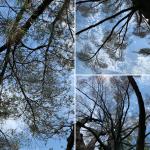 Crabapples with apple scab are shedding interior canopy leaves but new growth is continuing to develop. Sycamores have turned the corner and are producing quite a bit of new growth. Aphids can be found on a range of plants at this time, from flowering honeysuckle to Serbian spruce. The first Oriental beetle (Anomala orientalis) was observed this week. These invasive pests feed on a wide array of herbaceous and woody plants and last year populations were very high across the state. Mole, vole and shrew tunneling is increasing as new broods become independent. Bulbs are a feast for voles along with the roots of various herbaceous and woody plants. Sonic spikes can be inserted directly into their exit holes in an attempt to repel these annoying rodents. While the success rate is mixed, in some cases they can be effective. Mosquito and black fly populations continue to be very high.
Crabapples with apple scab are shedding interior canopy leaves but new growth is continuing to develop. Sycamores have turned the corner and are producing quite a bit of new growth. Aphids can be found on a range of plants at this time, from flowering honeysuckle to Serbian spruce. The first Oriental beetle (Anomala orientalis) was observed this week. These invasive pests feed on a wide array of herbaceous and woody plants and last year populations were very high across the state. Mole, vole and shrew tunneling is increasing as new broods become independent. Bulbs are a feast for voles along with the roots of various herbaceous and woody plants. Sonic spikes can be inserted directly into their exit holes in an attempt to repel these annoying rodents. While the success rate is mixed, in some cases they can be effective. Mosquito and black fly populations continue to be very high.
Berkshire Region (Great Barrington)
General Conditions: Similar to the pattern seen since the beginning of the year, the weather over the past week has taken a quick shift going from one extreme to the other. Following the very chilly conditions which occurred over the Memorial Day weekend when overnight lows dropped into the upper 30s and low 40s, overnight lows this week have been in the upper 50s and mid to upper 60s. Daytime highs since 6/5 have been well into the 80s and even hit the 90°F mark in some locales from 6/5 – 6/7. As a result, it has felt more like mid-summer than late spring. While this has hastened the completion of bloom on many ornamental trees and shrubs, herbaceous perennials are quickly becoming the source for June bloom. Tree pollen which occurred at very high levels earlier is now being replaced by grass pollen at high levels, an ongoing misery for those with pollen allergies. Soil moisture levels through the period were moderate to low. With this week’s showers, moisture levels are good and established plants show no drought stress. Growth of turf grass on fast draining sites has slowed from the rapid pace at which it grew in May but its growth has been steady. As of Wednesday, 6/9, precipitation for the year is about 2.5 inches below normal.
Pests/Problems: With the arrival of hot weather, pest activity has picked up. The population of black-legged ticks remains very high and only seems to be getting worse in terms of frequency of attachment to anyone spending time outdoors. Ticks are also being brought indoors in large numbers on a person’s clothing and via pets. Ticks are now in the nymph stage and are very tiny, making detection more difficult. Poison ivy is another problem when working in the landscape. It has spread rapidly and frequently can be found invading ground covers and roadsides. Studies by scientists at Duke University have shown that climate change, specifically increased levels of carbon dioxide in the atmosphere, has increased the growth rate and ultimate size of poison ivy. In addition, increased CO2 has increased the allergenic properties of urushiol, the chemical in poison ivy which causes rashes. On top of these nuisances, the mosquito population has greatly increased with the hotter, more humid weather. Plant pests observed this week include: gypsy moth (larvae abundant on oaks, birches, crabapples, and blueberry bushes), pear blister mites on ornamental pears, black lace elderberry borer, allium leaf miner on ornamental alliums, aphids on a wide variety of woody and herbaceous plants, spruce gall adelgids (nymph stage) on a couple of spruce species, rose slugs on roses, viburnum leaf beetle (larvae), woolly beech aphid, lily leaf beetle adults and larvae, and cutworms. Spittle bugs (nymphs) have made their appearance on several species of garden plants. They are not considered to be very damaging and most likely do not warrant control. Leaf galls are appearing on oaks and leaves of many other woody plants. Leaf galls result from feeding or egg laying by insects and mites. They may also be caused by fungi, bacteria and viruses. Despite the foliar distortions they cause, the damage rarely merits control measures. Few diseases were observed during this week’s scouting. These were limited to apple scab, cedar apple rust, and black spot on roses. One unusual item came up via an email from a person who was distraught over the huge number of red mites racing about on her concrete walk and the siding of her house. These were most likely clover mites, sometimes called concrete mites for their habit of congregating in large numbers on concrete surfaces. These mites are somewhat beneficial in that they feed on other mites and some insects, but they are a nuisance when they crawl over surfaces where you walk, sit, or eat. Complaints of rabbits and deer eating plants in gardens picked up a bit this week. Tunneling in lawns by voles was also noted as was the digging in lawns by skunks and snapping turtles.
Regional Scouting Credits
- CAPE COD REGION - Russell Norton, Horticulture and Agriculture Educator with Cape Cod Cooperative Extension, reporting from Barnstable.
- SOUTHEAST REGION - Brian McMahon, Arborist, reporting from the Dighton area.
- NORTH SHORE REGION - Geoffrey Njue, Green Industry Specialist, UMass Extension, reporting from the Long Hill Reservation, Beverly.
- EAST REGION - Kit Ganshaw & Sue Pfeiffer, Horticulturists reporting from the Boston area.
- METRO WEST REGION – Julie Coop, Forester, Massachusetts Department of Conservation & Recreation, reporting from Acton.
- CENTRAL REGION - Mark Richardson, Director of Horticulture reporting from Tower Hill Botanic Garden, Boylston.
- PIONEER VALLEY REGION - Nick Brazee, Plant Pathologist, UMass Extension Plant Diagnostic Lab, reporting from Amherst.
- BERKSHIRE REGION - Ron Kujawski, Horticultural Consultant, reporting from Great Barrington.
Woody Ornamentals
Diseases
Recent pests and pathogens of interest seen in the UMass Extension Plant Diagnostic Lab https://ag.umass.edu/services/plant-diagnostics-laboratory:
- Diplodia blight, caused by Diplodia sapinea, on mugo pine (Pinus mugo), Macedonian pine (Pinus peuce), Japanese black pine (Pinus thunbergii) and Japanese white pine (Pinus parviflora). The Japanese black and Macedonian pines are both mature (~25-years-old) and reside near the ocean on separate properties. Both trees receive full sun and supplemental irrigation. Needle browning and branch dieback developed in the canopies and Diplodia was abundant on the submitted samples. Coastal fog likely contributed to disease development. The Japanese white pine is much younger (approximately 10-years-old) and was transplanted last year. It has received no supplemental irrigation and is partially shaded at the site. This season, a large percentage of the interior canopy died.
- Verticillium wilt, caused by Verticillium dahliae, of October Glory red maple (Acer rubrum ‘October Glory’). The tree is less than 10-years-old and was planted four years ago. In late May, the tree developed wilt symptoms throughout the entire canopy and then quickly died. The same pattern of rapid symptom development occurred in the canopy of another maple in 2020. The two maples were approximately 20’ apart at the residential property. The submitted stems had no evidence of vascular staining, a symptom that is usually present when trees are infected by Verticillium. The collapsed foliage had blackened petioles, which can sometimes indicate maple anthracnose. However, the submitted roots had clear symptoms of decay. The roots were washed, the bark was removed, and small discs of root tissue were cut. These discs were then incubated on sterilized filter paper in a moist chamber for several days. From these incubated root discs, Verticillium produced its distinctive mycelia and black microsclerotia, which are seed-like structures that allow this fungus to persist in the soil. While maples are susceptible to Verticillium wilt, a variety of other hardwoods and conifers are resistant to immune.
- Birch anthracnose, caused by Ophiognomonia intermedia, on Heritage river birch (Betula nigra ‘Heritage’). The tree is mature (17’ tall with a 2.5” diameter) and was transplanted in late May of this year. Soil within the root ball was sandy and the new setting includes a mixture of sun and shade with average loam soils and regular hand-watering. Upon arrival at the site, the tree exhibited marginal leaf browning and curling. Birch anthracnose is typically not a serious disease but can result in significant leaf shedding in certain situations.
- Needle browning and branch dieback on a 10-year-old Fraser fir (Abies fraseri) due to transplant shock. The tree was transplanted in July of 2020 to a site with morning shade – afternoon sun and was hand-watered weekly. The 2020 needles and shoots were extremely stunted and no insect pests or fungal pathogens were present. This season, no new growth developed and needles began to turn reddish-brown throughout the canopy. While the tree was well cared for at the new site, it was not able to survive the transplant.
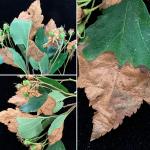 Infestation of the hawthorn leafminer (Profenusa canadensis) on Winter King hawthorn (Crataegus viridis ‘Winter King’). The trees are approximately 15-years-old and have been present at the site for 10 years. The site conditions include a mixture of sun and shade in well-drained soils with no supplemental irrigation. Over the past three years, the leaf margins turn brown by mid-May and symptoms have progressively worsened. Based on the symptoms, the managing arborist suspected a foliar blight. While the symptoms do mimic a foliar disease, the cause is infestation of the leaf miner alone. Adults of this wasp-like sawfly emerge as the leaves are developing and lay eggs in the upper epidermis of the leaf. The larvae then feed within the leaf and then drop to the soil in mid-June to pupate. When infestations are severe, a significant portion of the canopy has foliage with marginal browning.
Infestation of the hawthorn leafminer (Profenusa canadensis) on Winter King hawthorn (Crataegus viridis ‘Winter King’). The trees are approximately 15-years-old and have been present at the site for 10 years. The site conditions include a mixture of sun and shade in well-drained soils with no supplemental irrigation. Over the past three years, the leaf margins turn brown by mid-May and symptoms have progressively worsened. Based on the symptoms, the managing arborist suspected a foliar blight. While the symptoms do mimic a foliar disease, the cause is infestation of the leaf miner alone. Adults of this wasp-like sawfly emerge as the leaves are developing and lay eggs in the upper epidermis of the leaf. The larvae then feed within the leaf and then drop to the soil in mid-June to pupate. When infestations are severe, a significant portion of the canopy has foliage with marginal browning.- Brown spot needle blight caused by Lecanosticta acicola on Japanese red pine (Pinus densiflora ‘Umbraculifera’). The tree is mature, over 60-years-old and was planted in a very wet area with clay-based soils that drain poorly. However, it does receive full sun and had previously thrived. Over the past three years, needle browning and canopy thinning developed but symptoms have intensified in 2021. The symptoms are most severe in the lower canopy of the tree. The submitted sample included needles with ruptured spore-bearing pads and mature spores, indicating Lecanosticta was actively dispersing when the sample was collected. Early June is often the peak period of spore dispersal for pine needle pathogens like Lecanostica. This fungus is one of the primary needle blight pathogens associated with eastern white pine decline.
Report by Nick Brazee, Plant Pathologist, UMass Extension Plant Diagnostic Lab, UMass Amherst.
Insects
Upcoming Educational Programs:
Looking for more information about mosquitoes and preventing mosquito-borne disease? Don’t miss UMass Extension’s Mosquito Education Day!
June 15 – Mosquito Topics:
10:00 - 11:00 AM: Mosquitoes in Massachusetts, Arboviruses and Protecting Yourself, Dr. Jennifer Forman Orth, MA Dept. of Agricultural Resources
11:10 AM – 12:10 PM: Dealing With the Asian Tiger Mosquito: Incorporating an Invasive Species into an Existing Mosquito Control Program, Priscilla Matton, Superintendent, Bristol County Mosquito Control Project
For more information and to register, visit: https://ag.umass.edu/landscape/events/tick-mosquito-education-days
A Message from the University of Rhode Island Biocontrol Lab and Carleton University:
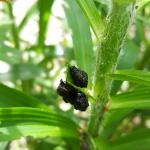 Hello fellow gardeners, naturalists, and lily enthusiasts,
Hello fellow gardeners, naturalists, and lily enthusiasts,
It has been twenty years since biological control agents (parasitic wasps) were first released in North America to combat the lily leaf beetle, a destructive pest of Asiatic lilies and fritillaries in gardens as well as native lilies in natural areas. In many areas, control of the beetle has been so effective that it is now hard to find lily beetles. However, there are still some areas where the beetle is spreading unchecked.
At this time, it is important for us to update the status of the lily leaf beetle and its biocontrol agents across North America. This will help us determine how effective the agents are and how far they have spread from the release sites. We will also be able to prioritize areas that are heavily hit by the beetle for the next releases.
Please help us with this task by visiting the lily beetle tracker website and responding to a very short survey. There is also an opportunity, explained on the website, to help us gather data on parasitism rates across the country—this would make a good project for homeschooled kids.
https://lilybeetletracker.weebly.com/new-2021-citizen-science.html
Please share the link with your gardening groups, naturalists' groups and anyone else who might be interested.
Many thanks and have a lovely summer,
Naomi Cappuccino, Carleton University
Lisa Tewksbury and Dick Casagrande, University of Rhode Island Biocontrol Lab
For More Information, Visit:
https://web.uri.edu/biocontrol/lily-leaf-beetle-larval-collections-2016/llb-citizen-science-2020/#
Insects and Other Arthropods of Medical Importance:
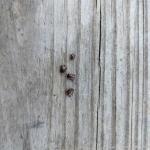
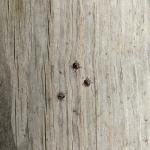 American Dog Tick: Anecdotally, Dermacentor variabilis adults are prevalent in certain locations of Massachusetts at this time. Reports from Cape Cod of adult dog ticks crawling on the siding of homes have been noted. Photographic evidence of adult dog ticks crawling up metal objects leaning against a home located in a heavily wooded area of Berkshire County, MA have also been reported recently (5/9/2021). The images shown here are adult stage dog ticks removed from a dog following a roadside walk in Hampshire County on both 5/6/21 (4 ticks removed) and 5/7/21 (3 ticks removed). Looking for more updates? Check out UMass Extension’s Tick Check with Blake Dinius, Plymouth County Extension Service and Larry Dapsis, Cape Cod Cooperative Extension: https://www.youtube.com/watch?v=gryCv8qB1qw
American Dog Tick: Anecdotally, Dermacentor variabilis adults are prevalent in certain locations of Massachusetts at this time. Reports from Cape Cod of adult dog ticks crawling on the siding of homes have been noted. Photographic evidence of adult dog ticks crawling up metal objects leaning against a home located in a heavily wooded area of Berkshire County, MA have also been reported recently (5/9/2021). The images shown here are adult stage dog ticks removed from a dog following a roadside walk in Hampshire County on both 5/6/21 (4 ticks removed) and 5/7/21 (3 ticks removed). Looking for more updates? Check out UMass Extension’s Tick Check with Blake Dinius, Plymouth County Extension Service and Larry Dapsis, Cape Cod Cooperative Extension: https://www.youtube.com/watch?v=gryCv8qB1qw
The American dog tick is found throughout most of North America. It may be encountered in forest edges, fields, along walkways and roadways, sidewalks, and trails. Adult stage ticks may be found on raccoons, skunks, cats, dogs, and other medium-sized hosts. Larvae and nymphs can be found on mice, voles, rats, and chipmunks. Adult males and females are active between April and early-August. Both adult males and females will feed, including on people. Nymphs and larvae of this species rarely attach to people or their pets. This species of tick can transmit lesser-known diseases such as Rocky Mountain Spotted Fever (not frequently infecting humans, according to CDC reports) and Tularemia (rarely infecting humans, according to CDC reports). For more information about the American dog tick, visit: https://web.uri.edu/tickencounter/species/dog-tick/ .
- Deer Tick/Blacklegged Tick: Check out the archived FREE TickTalk with TickReport webinars available here: https://ag.umass.edu/landscape/education-events/webinars .
*Ixodes scapularis - We are now entering the time of year when deer tick larvae and nymphs are frequently encountered. Larvae may be encountered in April, but in some locations may peak in their activity in August, while still being encountered through November. Nymphs are encountered from April through July, peaking in June. Nymphs are again present in October and November. For images of all deer tick life stages, along with an outline of the diseases they carry, and their timing of activity, visit: http://www.tickencounter.org/tick_identification/deer_tick .
Anyone working in the yard and garden should be aware that there is the potential to encounter deer ticks. The deer tick or blacklegged tick can transmit Lyme disease, human babesiosis, human anaplasmosis, and other diseases. Preventative activities, such as daily tick checks, wearing appropriate clothing, and permethrin treatments for clothing (according to label instructions) can aid in reducing the risk that a tick will become attached to your body. If a tick cannot attach and feed, it will not transmit disease. For more information about personal protective measures, visit: http://www.tickencounter.org/prevention/protect_yourself .
The Center for Agriculture, Food, and the Environment provides a list of potential tick identification and testing resources here: https://ag.umass.edu/resources/tick-testing-resources
*Note that deer ticks (Ixodes scapularis) are not the only disease-causing tick species found in Massachusetts. The American dog tick (Dermacentor variabilis) and the lone star tick (Amblyomma americanum) are also found throughout MA. Each can carry their own complement of diseases, including others not mentioned above. Anyone working or playing in tick habitats (wood-line areas, forested areas, and landscaped areas with ground cover) should check themselves regularly for ticks while practicing preventative measures.
- Mosquitoes: According to the Massachusetts Bureau of Infectious Disease and Laboratory Science and the Department of Public Health, there are at least 51 different species of mosquito found in Massachusetts. Mosquitoes belong to the Order Diptera (true flies) and the Family Culicidae (mosquitoes). As such, they undergo complete metamorphosis, and possess four major life stages: egg, larva, pupa, and adult. Adult mosquitoes are the only stage that flies and many female mosquitoes only live for 2 weeks (although the life cycle and timing will depend upon the species). Only female mosquitoes bite to take a blood meal, and this is so they can make eggs. Mosquitoes need water to lay their eggs in, so they are often found in wet or damp locations and around plants. Different species prefer different habitats. It is possible to be bitten by a mosquito at any time of the day, and again timing depends upon the species. Many are particularly active from just before dusk, through the night, and until dawn. Mosquito bites are not only itchy and annoying, but they can be associated with greater health risks. Certain mosquitoes vector pathogens that cause diseases such as West Nile virus (WNV) and eastern equine encephalitis (EEE).
For more information about mosquitoes in Massachusetts, visit: https://www.mass.gov/service-details/mosquitoes-in-massachusetts
There are ways to protect yourself against mosquitoes, including wearing long-sleeved shirts and long pants, keeping mosquitoes outside by using tight-fitting window and door screens, and using insect repellents as directed. Products containing the active ingredients DEET, permethrin, IR3535, picaridin, and oil of lemon eucalyptus provide protection against mosquitoes.
For more information about mosquito repellents, visit: https://www.mass.gov/service-details/mosquito-repellents and https://www.cdc.gov/mosquitoes/mosquito-bites/prevent-mosquito-bites.html .
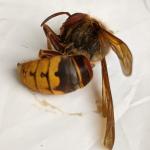
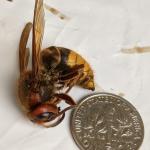 Wasps/Hornets: Many wasps are predators of other arthropods, including pest insects such as certain caterpillars that feed on trees and shrubs. Adult wasps hunt prey and bring it back to their nest where young are being reared, as food for the immature wasps. A common such example are the paper wasps (Polistes spp.) who rear their young on chewed up insects. They may be seen searching plants for caterpillars and other soft-bodied larvae to feed their young. Paper wasps can sting, and will defend their nests, which are open-celled paper nests that are not covered with a papery “envelope”. These open-celled nests may be seen hanging from eaves or other outdoor building structures. Aerial yellow jackets and hornets create large aerial nests that are covered with a papery shell or “envelope”. Common yellow jacket species include those in the genus Vespula. Dolichovespula maculata is commonly known as the baldfaced hornet, although it is not a true hornet. The European hornet (Vespa crabro) is three times the size of a yellow jacket and may be confused for the Asian giant hornet (Vespa mandarinia). The European hornet is known to Massachusetts, but the Asian giant hornet is not. If you are concerned that you have found or photographed an Asian giant hornet, please report it here: https://massnrc.org/pests/report.aspx . Paper wasps and aerial yellowjackets overwinter as fertilized females (queens) and a single female produces a new nest annually in the late spring. Nests are abandoned at the end of the season. Queens start new nests, lay eggs, and rear new wasps to assist in colony/nest development.Some people are allergic to stinging insects, so care should be taken around wasp/hornet nests. Unlike the European honeybee (Apis mellifera), wasps and hornets do not have barbed stingers, and therefore can sting repeatedly when defending their nests. It is best to avoid their nests, and if that cannot be done and assistance is needed to remove them, consult a professional.
Wasps/Hornets: Many wasps are predators of other arthropods, including pest insects such as certain caterpillars that feed on trees and shrubs. Adult wasps hunt prey and bring it back to their nest where young are being reared, as food for the immature wasps. A common such example are the paper wasps (Polistes spp.) who rear their young on chewed up insects. They may be seen searching plants for caterpillars and other soft-bodied larvae to feed their young. Paper wasps can sting, and will defend their nests, which are open-celled paper nests that are not covered with a papery “envelope”. These open-celled nests may be seen hanging from eaves or other outdoor building structures. Aerial yellow jackets and hornets create large aerial nests that are covered with a papery shell or “envelope”. Common yellow jacket species include those in the genus Vespula. Dolichovespula maculata is commonly known as the baldfaced hornet, although it is not a true hornet. The European hornet (Vespa crabro) is three times the size of a yellow jacket and may be confused for the Asian giant hornet (Vespa mandarinia). The European hornet is known to Massachusetts, but the Asian giant hornet is not. If you are concerned that you have found or photographed an Asian giant hornet, please report it here: https://massnrc.org/pests/report.aspx . Paper wasps and aerial yellowjackets overwinter as fertilized females (queens) and a single female produces a new nest annually in the late spring. Nests are abandoned at the end of the season. Queens start new nests, lay eggs, and rear new wasps to assist in colony/nest development.Some people are allergic to stinging insects, so care should be taken around wasp/hornet nests. Unlike the European honeybee (Apis mellifera), wasps and hornets do not have barbed stingers, and therefore can sting repeatedly when defending their nests. It is best to avoid their nests, and if that cannot be done and assistance is needed to remove them, consult a professional.
Woody ornamental insect and non-insect arthropod pests to consider, a selected few:
Invasive Insects & Other Organisms Update:
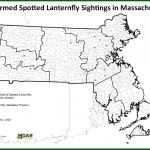 Spotted Lanternfly: (Lycorma delicatula, SLF) is not known to be established in Massachusetts landscapes at this time. However, due to the great ability of this insect to hitchhike using human-aided movement, it is important that we remain vigilant in Massachusetts and report any suspicious findings. Spotted lanternfly reports can be sent here: https://massnrc.org/pests/slfreport.aspx .
Spotted Lanternfly: (Lycorma delicatula, SLF) is not known to be established in Massachusetts landscapes at this time. However, due to the great ability of this insect to hitchhike using human-aided movement, it is important that we remain vigilant in Massachusetts and report any suspicious findings. Spotted lanternfly reports can be sent here: https://massnrc.org/pests/slfreport.aspx .
The Massachusetts Department of Agricultural Resources has recently released spotted lanternfly Best Management Practices for Nurseries and Landscapers: https://massnrc.org/pests/linkeddocuments/MANurseryBMPs.pdf
And Best Management Practices for Moving Companies and the Moving Industry: https://massnrc.org/pests/linkeddocuments/SLFChecklistMovingIndustryMA.pdf
Now is a great time to provide copies of these BMP’s to employees, customers, family, and friends! The more eyes we have out there looking for spotted lanternfly, the better. Use the above BMP’s as a guide to help you inspect certain items coming from CT, DE, MD, NC, NJ, NY, OH, PA, WV, and VA.
UMass Extension is teaming up with UMass Amherst’s Department of Environmental Conservation, the USDA APHIS, and the Massachusetts Department of Agricultural Resources to monitor for the spotted lanternfly in Massachusetts. A team including members of UMass Extension’s Landscape, Nursery, and Urban Forestry Program, Extension’s Fruit Program, Stockbridge School of Agriculture, and the Department of Environmental Conservation at UMass, Amherst are undertaking a nine-month integrated research and extension project to develop effective tools to detect the spotted lanternfly.
The researchers associated with this project (Dr. Joseph Elkinton, Dr. Jeremy Andersen and Dr. Jaime Pinero) will be working with Dr. Miriam Cooperband of the USDA APHIS lab on Cape Cod to identify and evaluate airborne attractants that can improve the ability to detect SLF in traps. Dr. Cooperband has identified several attractant lures released from host plants of SLF. She is currently working on pheromones produced by SLF that may be much more attractive. The UMass team will help her conduct field tests of these new lures, while also assisting the Massachusetts Department of Agricultural Resources (MDAR) in monitoring for SLF in Massachusetts. UMass Extension Entomologist, Tawny Simisky, will periodically report on progress made during the course of this project. For more information, please visit: https://ag.umass.edu/cafe/news/looking-for-spotted-lanternfly-recent-invasive-arrival
This insect is a member of the Order Hemiptera (true bugs, cicadas, hoppers, aphids, and others) and the Family Fulgoridae, also known as planthoppers. The spotted lanternfly is a non-native species first detected in the United States in Berks County, Pennsylvania and confirmed on September 22, 2014.
For a map of known, established populations of SLF as well as detections outside of these areas where individual finds of spotted lanternfly have occurred (but no infestations are present), visit: https://nysipm.cornell.edu/environment/invasive-species-exotic-pests/spotted-lanternfly/
The spotted lanternfly is considered native to China, India, and Vietnam. It has been introduced as a non-native insect to South Korea and Japan, prior to its detection in the United States. In South Korea, it is considered invasive and a pest of grapes and peaches. The spotted lanternfly has been reported feeding on over 103 species of plants, according to new research (Barringer and Ciafré, 2020) and when including not only plants on which the insect feeds, but those that it will lay egg masses on, this number rises to 172. This includes, but is not limited to, the following: tree of heaven (Ailanthus altissima) (preferred host), apple (Malus spp.), plum, cherry, peach, apricot (Prunus spp.), grape (Vitis spp.), pine (Pinus spp.), pignut hickory (Carya glabra), sassafras (Sassafras albidum), serviceberry (Amelanchier spp.), slippery elm (Ulmus rubra), tulip poplar (Liriodendron tulipifera), white ash (Fraxinus americana), willow (Salix spp.), American beech (Fagus grandifolia), American linden (Tilia americana), American sycamore (Platanus occidentalis), big-toothed aspen (Populus grandidentata), black birch (Betula lenta), black cherry (Prunus serotina), black gum (Nyssa sylvatica), black walnut (Juglans nigra), dogwood (Cornus spp.), Japanese snowbell (Styrax japonicus), maple (Acer spp.), oak (Quercus spp.), and paper birch (Betula papyrifera).
The adults and immatures of this species damage host plants by feeding on sap from stems, leaves, and the trunks of trees. In the springtime in Pennsylvania (late April - mid-May) nymphs (immatures) are found on smaller plants and vines and new growth of trees and shrubs. Third and fourth instar nymphs migrate to the tree of heaven and are observed feeding on trunks and branches. Trees may be found with sap weeping from the wounds caused by the insect’s feeding. The sugary secretions (excrement) created by this insect may coat the host plant, later leading to the growth of sooty mold. Insects such as wasps, hornets, bees, and ants may also be attracted to the sugary waste created by the lanternflies, or sap weeping from open wounds in the host plant. Host plants have been described as giving off a fermented odor when this insect is present.
Adults are present by the middle of July in Pennsylvania and begin laying eggs by late September and continue laying eggs through late November and even early December in that state. Adults may be found on the trunks of trees such as the tree of heaven or other host plants growing in close proximity to them. Egg masses of this insect are gray in color and look similar in some ways to gypsy moth egg masses.
Host plants, bricks, stone, lawn furniture, recreational vehicles, and other smooth surfaces can be inspected for egg masses. Egg masses laid on outdoor residential items such as those listed above may pose the greatest threat for spreading this insect via human aided movement.
For more information about the spotted lanternfly, visit this fact sheet: https://ag.umass.edu/landscape/fact-sheets/spotted-lanternfly .
- Emerald Ash Borer: (Agrilus planipennis, EAB) Since the New Year, the Massachusetts Department of Conservation and Recreation has confirmed at least 22 new community detections of emerald ash borer in Massachusetts. To date, 11 out of the 14 counties in Massachusetts have confirmed emerald ash borer. (The remaining counties where EAB has yet to be detected are Barnstable, Dukes, and Nantucket counties.)A map of these locations and others previously known across the state may be found here: https://ag.umass.edu/fact-sheets/emerald-ash-borer .
This wood-boring beetle readily attacks ash (Fraxinus spp.) including white, green, and black ash and has also been found developing in white fringe tree (Chionanthus virginicus) and has been reported in cultivated olive (Olea europaea). Adult insects of this species will not be present at this time of year. Signs of an EAB infested tree may include (at this time) D-shaped exit holes in the bark (from adult emergence in previous years), “blonding” or lighter coloration of the ash bark from woodpecker feeding (chipping away of the bark as they search for larvae beneath), and serpentine galleries visible through splits in the bark, from larval feeding beneath. It is interesting to note that woodpeckers are capable of eating 30-95% of the emerald ash borer larvae found in a single tree (Murphy et al. 2018). Unfortunately, despite high predation rates, EAB populations continue to grow.
For further information about this insect, please visit: https://ag.umass.edu/fact-sheets/emerald-ash-borer . If you believe you have located EAB-infested ash trees, particularly in an area of Massachusetts not identified on the map provided, please report here: https://massnrc.org/pests/eabreport.htm .
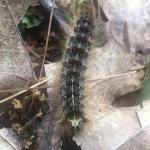
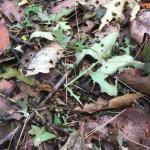
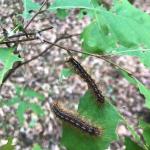
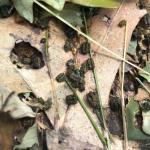
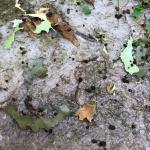
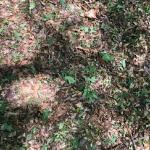 Gypsy Moth:(Lymantria dispar) thanks to the gypsy moth caterpillar killing fungus, Entomophaga maimaiga, the recent outbreak of gypsy moth in Massachusetts has come to an end! Most locations in Massachusetts will not see damaging or even noticeable populations of this insect in 2021. However, there have been recent reports of gypsy moth caterpillars feeding on susceptible hosts in some locations in western Massachusetts, particularly in Berkshire County (ex. Alford, Great Barrington, Richmond, South Egremont, and Williamstown). (Ex. On 6/9/21, a report from Great Barrington, MA noted that caterpillars were defoliating trees in a forested area, and that caterpillar frass (excrement) was seen raining down from the canopy.) While this may be the case in certain locations, we do not expect widespread defoliation (to the extent that we saw in 2017) from this insect in 2021 in MA. Another note for 6/9/2021: there have been reports of increased gypsy moth activity in certain locations in New York. Massachusetts residents vacationing or with second homes in that state are reporting defoliation on oaks and pines in NY. For more information, visit: https://www.dec.ny.gov/animals/83118.html
Gypsy Moth:(Lymantria dispar) thanks to the gypsy moth caterpillar killing fungus, Entomophaga maimaiga, the recent outbreak of gypsy moth in Massachusetts has come to an end! Most locations in Massachusetts will not see damaging or even noticeable populations of this insect in 2021. However, there have been recent reports of gypsy moth caterpillars feeding on susceptible hosts in some locations in western Massachusetts, particularly in Berkshire County (ex. Alford, Great Barrington, Richmond, South Egremont, and Williamstown). (Ex. On 6/9/21, a report from Great Barrington, MA noted that caterpillars were defoliating trees in a forested area, and that caterpillar frass (excrement) was seen raining down from the canopy.) While this may be the case in certain locations, we do not expect widespread defoliation (to the extent that we saw in 2017) from this insect in 2021 in MA. Another note for 6/9/2021: there have been reports of increased gypsy moth activity in certain locations in New York. Massachusetts residents vacationing or with second homes in that state are reporting defoliation on oaks and pines in NY. For more information, visit: https://www.dec.ny.gov/animals/83118.html
Gypsy moth has been in Massachusetts since the 1860's. This invasive insect from Europe often goes unnoticed, thanks to population regulation provided by the entomopathogenic fungus, E. maimaiga, as well as a NPV virus specific to gypsy moth caterpillars. (And to a lesser extent many other organisms, including other insects, small mammals, and birds who feed on gypsy moth.) However, if environmental conditions do not favor the life cycle of the fungus, outbreaks of gypsy moth caterpillars are possible. (Such as most recently from 2015-2018, with a peak in the gypsy moth population in 2017 in Massachusetts.)
Check out Episode 1 of InsectXaminer to reminisce about the 2015-2018 outbreak of this insect: https://ag.umass.edu/landscape/education-events/insectxaminer
- Asian Longhorned Beetle: (Anoplophora glabripennis, ALB) Look for signs of an ALB infestation which include perfectly round exit holes (about the size of a dime), shallow oval or round scars in the bark where a female has chewed an egg site, or sawdust-like frass (excrement) on the ground nearby host trees or caught in between branches. Be advised that other, native insects may create perfectly round exit holes or sawdust-like frass, which can be confused with signs of ALB activity.
The regulated area for Asian longhorned beetle is 110 miles2 encompassing Worcester, Shrewsbury, Boylston, West Boylston, and parts of Holden and Auburn. If you believe you have seen damage caused by this insect, such as exit holes or egg sites, on susceptible host trees like maple, please call the Asian Longhorned Beetle Eradication Program office in Worcester, MA at 508-852-8090 or toll free at 1-866-702-9938.
To report an Asian longhorned beetle find online or compare it to common insect look-alikes, visit: http://massnrc.org/pests/albreport.aspx or https://www.aphis.usda.gov/pests-diseases/alb/report .
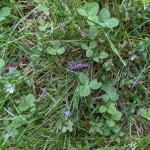 White Spotted Pine Sawyer (WSPS): Monochamus scutellatus adults can emerge in late May throughout July, depending on local temperatures. This is a native insect in Massachusetts and is usually not a pest. Larvae develop in weakened or recently dead conifers, particularly eastern white pine (Pinus strobus). However, the white spotted pine sawyer looks very similar to the invasive Asian Longhorned Beetle, Anoplophora glabripennis, ALB. ALB adults do not emerge in Massachusetts until July and August. Beginning in July, look for the key difference between WSPS and ALB adults, which is a white spot in the top center of the wing covers (the scutellum) on the back of the beetle. White spotted pine sawyer will have this white spot, whereas Asian longhorned beetle will not. Both insects can have other white spots on the rest of their wing covers; however, the difference in the color of the scutellum is a key characteristic. See the Asian longhorned beetle entry above for more information about that non-native insect.
White Spotted Pine Sawyer (WSPS): Monochamus scutellatus adults can emerge in late May throughout July, depending on local temperatures. This is a native insect in Massachusetts and is usually not a pest. Larvae develop in weakened or recently dead conifers, particularly eastern white pine (Pinus strobus). However, the white spotted pine sawyer looks very similar to the invasive Asian Longhorned Beetle, Anoplophora glabripennis, ALB. ALB adults do not emerge in Massachusetts until July and August. Beginning in July, look for the key difference between WSPS and ALB adults, which is a white spot in the top center of the wing covers (the scutellum) on the back of the beetle. White spotted pine sawyer will have this white spot, whereas Asian longhorned beetle will not. Both insects can have other white spots on the rest of their wing covers; however, the difference in the color of the scutellum is a key characteristic. See the Asian longhorned beetle entry above for more information about that non-native insect.- Jumping Worms: In recent years, public concern about Amynthas spp. earthworms, collectively referred to as “jumping or crazy or snake” worms, has dramatically increased. University researchers and Extension groups in many locations in the US are finding that these species cause not only forest ecosystem disturbances, but may also negatively impact soil structure and reduce plant growth in gardens and managed landscapes. They do this by voraciously devouring the organic layer of the soil while feeding very close to the soil surface, unlike other species of earthworms. In woodland areas, they can quickly eat all of the leaf litter on the forest floor. Jumping worms also leave a distinct grainy soil full of worm castings. The soil becomes granular and may look like dried coffee grounds.
Unfortunately, there are currently no research-based management options available for these earthworms. So prevention is essential – preventing their introduction and spread into new areas is the best defense against them. Adult jumping worms can be 1.5 – 8 inches or more in length. Their clitellum (collar-like ring) is roughly located 1/3 down the length of the worm (from the head) and is smooth and cloudy-white and constricted. These worms may also wiggle or jump when disturbed, and can move across the ground in an S-shape like a snake. While the exact timing of their life cycle in MA might not be completely understood, their life cycle may be expected to go (roughly) something like this: they hatch in the late spring in 1-4 inches of soil, mature into adults during the summer and adults lay eggs sometime in August, and it is thought that their cocoons overwinter. (Adults perish with frost.) It is also worth noting here that jumping worms do not directly harm humans or pets.
For more information, listen to Dr. Olga Kostromytska’s presentation here: https://ag.umass.edu/landscape/education-events/invasive-insect-webinars
Suggested reading includes Dr. Kostromytska’s recent “Hot Topics” article in Hort Notes (including an identification guide), here: https://ag.umass.edu/landscape/newsletters/hort-notes/hort-notes-2021-vol-323
Additional resources can also be found here:
University of Minnesota Extension: https://extension.umn.edu/identify-invasive-species/jumping-worms
Cornell Cooperative Extension: http://ulster.cce.cornell.edu/environment/invasive-pests/jumping-worm
UNH Extension: https://extension.unh.edu/blog/invasive-spotlight-jumping-worms
Tree & Shrub Insects & Mites:
- Arborvitae Leafminer: In New England and eastern Canada, four species of leafminers are known to infest arborvitae. These include Argyresthia thuiella, A. freyella, A. aureoargentella, and Coleotechnites thujaella. The arborvitae leafminer, A. thuiella, is the most abundant of these and has the greatest known range when compared to the others. (It is also found in the Mid-Atlantic States and as far west as Missouri). Moths of this species appear from mid-June to mid-July and lay their eggs. The damage caused by all of these species is nearly identical. Trees, however, have been reported to lose up to 80% of their foliage due to arborvitae leafminer and still survive. At least 27 species of parasites have been reported as natural enemies of arborvitae leafminers, the most significant of which may be a parasitic wasp (Pentacnemus bucculatricis). Arborvitae leafminer damage causes the tips of shoots and foliage to turn yellow and brown. If infestations are light, prune out infested tips.
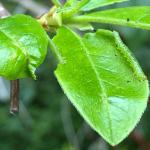
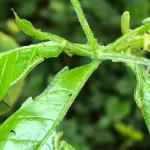 Azalea Sawflies: There are a few species of sawflies that impact azaleas. Johnson and Lyon's Insects that Feed on Trees and Shrubs mentions three of them. Amauronematus azaleae was first reported in New Hampshire in 1895 and is likely found in most of New England. Adults of this species are black with some white markings and wasp-like. Generally green larvae feed mostly on mollis hybrid azaleas. Remember, sawfly caterpillars have at least enough abdominal prolegs to spell “sawfly” (so 6 or more prolegs). Adults are present in May, and females lay their eggs and then larvae hatch and feed through the end of June. There is one generation per year. Nematus lipovskyi has been reared from swamp azalea (Rhododendron viscosum). Adults of that species have been collected in April (in states to the south) and May (in New England) and larval feeding is predominantly in late April and May in Virginia and June in New England. One generation of this species occurs per year, and most mollis hybrid azaleas can be impacted. A third species, Arge clavicornis, is found as an adult in July and lays its eggs in leaf edges in rows. Larvae are present in August and September. Remember, Bacillus thuringiensis Kurstaki does not manage sawflies.
Azalea Sawflies: There are a few species of sawflies that impact azaleas. Johnson and Lyon's Insects that Feed on Trees and Shrubs mentions three of them. Amauronematus azaleae was first reported in New Hampshire in 1895 and is likely found in most of New England. Adults of this species are black with some white markings and wasp-like. Generally green larvae feed mostly on mollis hybrid azaleas. Remember, sawfly caterpillars have at least enough abdominal prolegs to spell “sawfly” (so 6 or more prolegs). Adults are present in May, and females lay their eggs and then larvae hatch and feed through the end of June. There is one generation per year. Nematus lipovskyi has been reared from swamp azalea (Rhododendron viscosum). Adults of that species have been collected in April (in states to the south) and May (in New England) and larval feeding is predominantly in late April and May in Virginia and June in New England. One generation of this species occurs per year, and most mollis hybrid azaleas can be impacted. A third species, Arge clavicornis, is found as an adult in July and lays its eggs in leaf edges in rows. Larvae are present in August and September. Remember, Bacillus thuringiensis Kurstaki does not manage sawflies.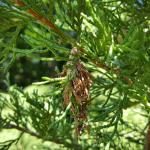 Bagworm: Thyridopteryx ephemeraeformis is a native species of moth whose larvae construct bag-like coverings over themselves with host plant leaves and twigs. This insect overwinters in the egg stage, within the bags of deceased females from last season. Eggs may hatch and young larvae are observed feeding around mid-June, or roughly between 600-900 GDD’s. In certain areas across MA in 2020, increased populations of bagworms were observed and reported, particularly in urban forest settings and managed landscapes. More information can be found here: https://ag.umass.edu/landscape/fact-sheets/bagworm
Bagworm: Thyridopteryx ephemeraeformis is a native species of moth whose larvae construct bag-like coverings over themselves with host plant leaves and twigs. This insect overwinters in the egg stage, within the bags of deceased females from last season. Eggs may hatch and young larvae are observed feeding around mid-June, or roughly between 600-900 GDD’s. In certain areas across MA in 2020, increased populations of bagworms were observed and reported, particularly in urban forest settings and managed landscapes. More information can be found here: https://ag.umass.edu/landscape/fact-sheets/bagworm- Boxwood Leafminer: Monarthropalpus flavus partly grown fly larvae overwinter in the leaves of susceptible boxwood. Yellowish mines may be noticeable on the undersides of leaves. This insect grows rapidly in the spring, transforming into an orange-colored pupa. After pupation, adults will emerge and white colored pupal cases may hang down from the underside of leaves where adults have emerged. Adults may be observed swarming hosts between 300-650 GDD’s, or roughly the end of May through June. Most cultivars of Buxus sempervirens and B. microphylla are thought to be susceptible. If installing new boxwoods this spring, resistant cultivars such as ‘Vardar Valley’ and ‘Handsworthiensis’ are good choices at sites where this insect has been a problem.
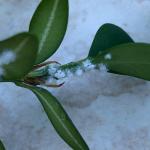
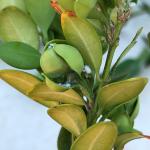 Boxwood Psyllid: Psylla buxi feeding can cause cupping of susceptible boxwood leaves. Leaf symptoms/damage may remain on plants for up to two years. English boxwood may be less severely impacted by this pest. Eggs overwinter, buried in budscales, and hatch around budbreak of boxwood. Eggs may hatch around 80 GDD’s. Foliar applications may be made between 290-440 GDD’s. However, the damage caused by this insect is mostly aesthetic. Therefore, no management may be necessary.
Boxwood Psyllid: Psylla buxi feeding can cause cupping of susceptible boxwood leaves. Leaf symptoms/damage may remain on plants for up to two years. English boxwood may be less severely impacted by this pest. Eggs overwinter, buried in budscales, and hatch around budbreak of boxwood. Eggs may hatch around 80 GDD’s. Foliar applications may be made between 290-440 GDD’s. However, the damage caused by this insect is mostly aesthetic. Therefore, no management may be necessary.- Cottony Taxus Scale: Pulvinaria floccifera, also referred to as the cottony camellia scale, utilizes such hosts as taxus, camellia, holly, hydrangea, Japanese maple, euonymus, magnolia, and jasmine, among others. Females have laid the long, narrow, white and fluted egg sac that makes them much more noticeable. Eggs will hatch over an extended period of 6 weeks and crawlers may be treated between 802-1388 GDD’s. This insect can cause the host to appear off-color. They also produce honeydew which promotes sooty mold growth. Dieback is not common with this insect. Target the underside of the foliage. Horticultural oil, neem oil, and insecticidal soaps may be used to manage these soft scales. Reduced risk options help preserve natural enemies.
- Dogwood Borer: Synanthedon scitula is a species of clearwing moth whose larvae bore not only into dogwood (Cornus), but hosts also include flowering cherry, chestnut, apple, mountain ash, hickory, pecan, willow, birch, bayberry, oak, hazel, myrtle, and others. Kousa dogwood appear to be resistant to this species. Signs include the sloughing of loose bark, brown frass, particularly near bark cracks and wounds, dead branches, and adventitious growth. The timing of adult emergence can be expected when dogwood flower petals are dropping and weigela begins to bloom. Adult moth flights continue from then until September. Emergence in some hosts (ex. apple) appears to be delayed, but this differs depending upon the location in this insect’s range. Eggs are laid singly, or in small groups, on smooth and rough bark. Female moths preferentially lay eggs near wounded bark. After hatch, larvae wander until they find a suitable entrance point into the bark. This includes wounds, scars, or branch crotches. This insect may also be found in twig galls caused by other insects or fungi. Larvae feed on phloem and cambium. Fully grown larvae are white with a light brown head and approx. ½ inch long. Pheromone traps and lures are useful for determining the timing of adult moth emergence and subsequent management.
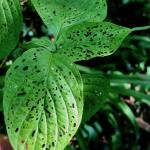
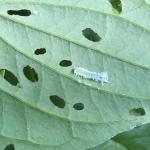 Dogwood Sawfly: Macremphytus tarsatus larvae are commonly seen feeding on dogwoods, especially gray dogwood (Cornus racemosa). One generation occurs per year. The larvae of the dogwood sawfly overwinter in decaying wood and occasionally (rarely) compromised structural timber. An overwintering “cell” is created in this soft wood. Pupation occurs in the springtime and adults can take a lengthy time to emerge, roughly from late May through July. 100+ eggs are laid in groups on the underside of leaves. Eggs hatch and the larvae feed gregariously, initially skeletonizing the leaves. As the caterpillars grow in size, they are capable of eating the entire leaf, leaving only midveins behind. Larval appearance varies greatly throughout instars. Early instars are translucent and yellow, but as the caterpillars grow, they develop black spots (over the yellow) and become covered in a white powder-like material. Larvae and their shed skins may resemble bird droppings. Full-grown larvae begin to wander in search of a suitable overwintering location. Rotting wood lying on the ground is preferred for this. Sawfly caterpillars can be collected from plants and dropped into a can of soapy water.
Dogwood Sawfly: Macremphytus tarsatus larvae are commonly seen feeding on dogwoods, especially gray dogwood (Cornus racemosa). One generation occurs per year. The larvae of the dogwood sawfly overwinter in decaying wood and occasionally (rarely) compromised structural timber. An overwintering “cell” is created in this soft wood. Pupation occurs in the springtime and adults can take a lengthy time to emerge, roughly from late May through July. 100+ eggs are laid in groups on the underside of leaves. Eggs hatch and the larvae feed gregariously, initially skeletonizing the leaves. As the caterpillars grow in size, they are capable of eating the entire leaf, leaving only midveins behind. Larval appearance varies greatly throughout instars. Early instars are translucent and yellow, but as the caterpillars grow, they develop black spots (over the yellow) and become covered in a white powder-like material. Larvae and their shed skins may resemble bird droppings. Full-grown larvae begin to wander in search of a suitable overwintering location. Rotting wood lying on the ground is preferred for this. Sawfly caterpillars can be collected from plants and dropped into a can of soapy water.
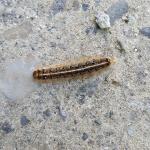 Eastern Tent Caterpillar: Malacosoma americanum eggs overwinter on host plant twigs. Egg hatch typically occurs when wild cherry leaves begin to unfold and young caterpillars may emerge by late-April through the first two weeks in May (90-190 GDD’s). Susceptible hosts include cherry and crabapple. Other host plants whose leaves are fed upon by this native insect can include apple, ash, birch, willow, maple, oak, poplar, and witch-hazel. Prune off and remove egg masses from ornamental host plants by early spring. Eastern tent caterpillars are native to Massachusetts and have many associated natural enemies (parasites and predators) that help regulate populations. Unless these caterpillars are actively defoliating specimen trees in a landscaped setting, we can coexist with this particular herbivore native to our forests.
Eastern Tent Caterpillar: Malacosoma americanum eggs overwinter on host plant twigs. Egg hatch typically occurs when wild cherry leaves begin to unfold and young caterpillars may emerge by late-April through the first two weeks in May (90-190 GDD’s). Susceptible hosts include cherry and crabapple. Other host plants whose leaves are fed upon by this native insect can include apple, ash, birch, willow, maple, oak, poplar, and witch-hazel. Prune off and remove egg masses from ornamental host plants by early spring. Eastern tent caterpillars are native to Massachusetts and have many associated natural enemies (parasites and predators) that help regulate populations. Unless these caterpillars are actively defoliating specimen trees in a landscaped setting, we can coexist with this particular herbivore native to our forests.- Elongate Hemlock Scale: Fiorinia externa is found on eastern, Carolina, and Japanese hemlock, as well as yew, spruce, and fir. The elongate hemlock scale may overwinter in various life stages, and overlap of many developmental stages at any given time can be observed throughout much of the season. Treatments for the crawler, or mobile, stage of this insect may be made in late May through mid-June, or between 360-700 GDD’s, base 50°F. Nitrogen fertilizer applications may make elongate hemlock scale infestations worse.
- Euonymus Caterpillar: Yponomeuta cagnagella is of European origin and widespread in distribution throughout Europe. It was first reported in North America in Ontario in 1967. The euonymus caterpillars (larvae) feed in groups and envelop the foliage of the host plant in webs as they feed. Hosts include: Euonymus europaeus (tree form), E. kiautschovicus, E. alatus, and E. japonicus. Mature caterpillars are just under an inch in length, creamy yellow-gray in color with black spots and a black head capsule. By late June, these larvae pupate in white, oval-shaped cocoons which are typically oriented together vertically either on host plants or non-hosts in the area. Cocoons can be found in cracks and crevices, or webbed together leaves. The adult moth emerges in late June in most locations. The adult female secretes a gummy substance over her eggs which will harden, making them even more difficult to see. Eggs hatch by mid-August, at which time the tiny larvae prepare to overwinter beneath their eggshell-like covering. These larvae are inactive until the following year, when caterpillars group together to feed on newly emerging leaves, creating a mess of webs as they feed. There is one generation per year. Plants may be partially or entirely defoliated. Management of young, actively feeding caterpillars with Bacillus thuringiensis is possible if deemed necessary, however many species of Euonymus are considered invasive themselves.
Check out Episode 3 of InsectXaminer to see the euonymus caterpillar in action and learn more about its life cycle: https://ag.umass.edu/landscape/education-events/insectxaminer
- Euonymus Scale: Unaspis euonymi is an armored scale that can be found on euonymus, holly, bittersweet, and pachysandra. This insect can cause yellow spotting on leaves, dieback, and distorted bark. For crawlers, early June timing is suggested between 533-820 GDD’s. (Eggs begin to hatch in early June.)
- European Pine Sawfly: Neodiprion sertifer overwinters in the egg stage. Eggs are laid by females the previous season by cutting slits in needles using their ovipositors and depositing 6-8 eggs in each of 10-12 needles. Egg hatch occurs from late-April to mid-May and caterpillars become active roughly between 78-220 GDD, base 50°F. The primary host in MA is Mugo pine but it can be found on Scots, red, jack, and Japanese red pine. It is also found on white, Austrian, ponderosa, shortleaf, and pitch pine when planted near the aforementioned species. This dark colored caterpillar feeds in tight groups and small numbers can be pruned or plucked out of host plants and destroyed. Spinosad products can be used whenever the caterpillars are actively feeding, usually by mid-May and when caterpillars are still small. Bacillus thuringiensis kurstaki is not effective against sawflies.
- Fletcher Scale: Parthenolecanium fletcheri is a soft scale pest of yew, juniper, and arborvitae. Feeding scales, especially on yew, result in honeydew and sooty mold, needle yellowing, and at times, premature needle drop. There is one generation per year. Overwintered second instar nymphs can be targeted between 38-148 GDD’s, base 50°F. Nymphs develop and adult females lay eggs (on average 500-600) in May that hatch by June. Dead females conceal egg masses beneath. Crawlers migrate short distances to branches and may be concentrated on certain branches of a particular plant.
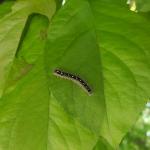 Forest Tent Caterpillar: Malacosoma disstria egg hatch occurs between 192-363 GDD’s, base 50°F, by mid-late May and caterpillars may be active for at least 5-6 weeks following. Susceptible hosts whose leaves are fed on by this insect include oak, birch, ash, maple, elm, poplar, and basswood. This native insect has many natural enemies, including some very effective pathogens that typically regulate populations. However, outbreaks of this insect can occur on occasion.
Forest Tent Caterpillar: Malacosoma disstria egg hatch occurs between 192-363 GDD’s, base 50°F, by mid-late May and caterpillars may be active for at least 5-6 weeks following. Susceptible hosts whose leaves are fed on by this insect include oak, birch, ash, maple, elm, poplar, and basswood. This native insect has many natural enemies, including some very effective pathogens that typically regulate populations. However, outbreaks of this insect can occur on occasion.- Hemlock Looper: Two species of geometrid moths in the genus Lambdina are native insects capable of defoliating eastern hemlock, balsam fir, and white spruce. Adult moths lay their eggs on the trunk and limbs of hosts in September and October, and eggs will hatch by late May or early June. (L. fiscellaria caterpillars may be active between 448-707 GDD’s.) Monitor susceptible hosts for small, inch-worm like caterpillars. Where populations are low, no management is necessary. Hemlock loopers have several effective natural enemies.
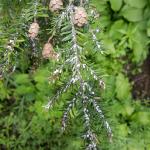
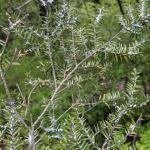
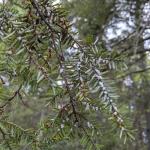 Hemlock Woolly Adelgid: Adelges tsugae is present on eastern and Carolina hemlock. The overwintering hemlock woolly adelgid generation (sistens) is present through mid-spring and produces the spring generation (progrediens) which will be present from early spring through mid-summer. HWA, unlike many other insects, does most of its feeding over the winter. Eggs may be found in woolly masses at the base of hemlock needles beginning in mid-March. Each woolly mass is created by a female who may then lay 50-300 eggs. Eggs hatch and crawlers may be found from mid-March through mid-July. Infested trees may be treated with foliar sprays in late April to early May, using Japanese quince as a phenological indicator. Systemic applications may be made in the spring and fall, or when soil conditions are favorable for translocation to foliage. Nitrogen fertilizer applications may make hemlock woolly adelgid infestations worse.
Hemlock Woolly Adelgid: Adelges tsugae is present on eastern and Carolina hemlock. The overwintering hemlock woolly adelgid generation (sistens) is present through mid-spring and produces the spring generation (progrediens) which will be present from early spring through mid-summer. HWA, unlike many other insects, does most of its feeding over the winter. Eggs may be found in woolly masses at the base of hemlock needles beginning in mid-March. Each woolly mass is created by a female who may then lay 50-300 eggs. Eggs hatch and crawlers may be found from mid-March through mid-July. Infested trees may be treated with foliar sprays in late April to early May, using Japanese quince as a phenological indicator. Systemic applications may be made in the spring and fall, or when soil conditions are favorable for translocation to foliage. Nitrogen fertilizer applications may make hemlock woolly adelgid infestations worse.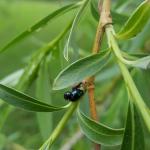
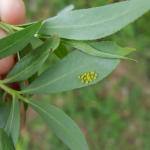 Imported Willow Leaf Beetle: Plagiodera versicolora adult beetles overwinter near susceptible hosts. Adult beetles will chew holes and notches in the leaves of willow once they become available. Females lay yellow eggs in clusters on the undersides of leaves. Larvae are slug-like and bluish-green in color. They will feed in clusters and skeletonize the leaves. Most plants can tolerate the feeding from this insect, and foliage will appear brown. Repeated yearly feeding can be an issue, in which case management of the young larvae may be necessary. Take care with treatment in areas near water.
Imported Willow Leaf Beetle: Plagiodera versicolora adult beetles overwinter near susceptible hosts. Adult beetles will chew holes and notches in the leaves of willow once they become available. Females lay yellow eggs in clusters on the undersides of leaves. Larvae are slug-like and bluish-green in color. They will feed in clusters and skeletonize the leaves. Most plants can tolerate the feeding from this insect, and foliage will appear brown. Repeated yearly feeding can be an issue, in which case management of the young larvae may be necessary. Take care with treatment in areas near water.
Check out Episode 4 of InsectXaminer to see the imported willow leaf beetle in action and learn more about its life cycle: https://ag.umass.edu/landscape/education-events/insectxaminer
- Lacebugs: Stephanitis spp. lacebugs such as S. pyriodes can cause severe injury to azalea foliage. S. rhododendri can be common on rhododendron and mountain laurel. S. takeyai has been found developing on Japanese andromeda, leucothoe, styrax, and willow. Stephanitis spp. lace bug activity should be monitored through September. Before populations become too large, treat with a summer rate horticultural oil spray as needed. Be sure to target the undersides of the foliage in order to get proper coverage of the insects. Certain azalea and andromeda cultivars may be less preferred by lace bugs.
- Lilac Borer: Podosesia syringae is a clearwing moth pest of lilac, privet, fringetree, and ash. (It is also known as the ash borer, not to be confused with the emerald ash borer.) Adults mimic paper wasps. Larvae are wood-boring, and signs and symptoms include branch dieback, holes, and occasionally, sawdust-like frass accumulated on bark. Larvae bore into stems, trunks, and branches, chewing an irregularly shaped entrance hole. Peak adult moth flights may occur in the northern portion of this insect’s range in June and is usually over by August 1st. Pheromone traps can be used to time adult emergence. Adult females lay flattened, oval, and tan eggs that are deposited singly or in clusters on bark crevices, ridges, and sometimes smooth bark; but usually laid in or near wounds in the bark. On average, 395 eggs are laid by each female. After hatch, larvae chew into the bark and feed laterally and then vertically in phloem tissue. Larvae overwinter in tunnels in the final instar and resume feeding in the spring. Adults emerge through a round exit hole (4-5 mm. in diameter). This insectmay be targeted between 200-299 GDD’s, base 50°F.
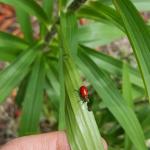
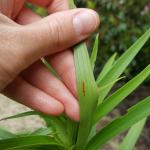
 Lily Leaf Beetle: Lilioceris lilii adults overwinter in sheltered places. As soon as susceptible hosts such as Lilium spp. (Turk’s cap, tiger, Easter, Asiatic, and Oriental lilies) and Fritillaria spp. break through the ground, the adult lily leaf beetles are known to feed on the new foliage. (Note: daylilies are not hosts.) Typically, in May, mating will occur and each female will begin to lay 250-450 eggs in neat rows on the underside of the foliage. If there are only a few plants in the garden, hand picking and destroying overwintering adults can help reduce local garden-level populations at that time. As eggs hatch and growing larvae begin to feed, the larvae of this insect can be removed from plants as well.
Lily Leaf Beetle: Lilioceris lilii adults overwinter in sheltered places. As soon as susceptible hosts such as Lilium spp. (Turk’s cap, tiger, Easter, Asiatic, and Oriental lilies) and Fritillaria spp. break through the ground, the adult lily leaf beetles are known to feed on the new foliage. (Note: daylilies are not hosts.) Typically, in May, mating will occur and each female will begin to lay 250-450 eggs in neat rows on the underside of the foliage. If there are only a few plants in the garden, hand picking and destroying overwintering adults can help reduce local garden-level populations at that time. As eggs hatch and growing larvae begin to feed, the larvae of this insect can be removed from plants as well.
Check out Episode 3 of InsectXaminer to see the lily leaf beetle in action and learn more about its life cycle: https://ag.umass.edu/landscape/education-events/insectxaminer
- Magnolia Scale: Neolecanium cornuparvum overwinters as first instar nymphs which are elliptical, and dark slate gray in color and can usually be found on the undersides of 1 and 2 year old twigs. Nymphs may molt by late April or May and again by early June at which time the scales may be purple in color. Eventually nymphs secrete a white powdery layer of wax over their bodies.
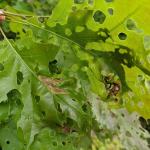
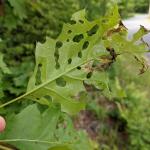 Oak Shothole Leafminer: The oak shothole leafminer (Japanagromyza viridula synonym Agromyza viridula) is considered native to the United States, although very little is known about this species and other agromyzid leaf miners. It is reportedly found throughout the eastern U.S. from Maine to Georgia, and likely the entire eastern half of the United States. The damage caused by the activity of the adult female oak shothole leafminer is characteristic of this fly species. Adult female flies are active when red and white oak buds are just opening and until the newly developing leaves are approximately 5 cm (~2") in length. The holes seen in these images were created when the leaves were no more than 4.5 cm (~1 3/4") long. This damage is caused by the adult female fly feeding. Because the fly’s mouthparts are unable to pierce the newly developing leaf tissue, it uses its ovipositor to cause enough damage such that any fluids leaking from the leaf can then be lapped up. The female fly will move the ovipositor in side-to-side and circular motions, creating initial injury that is no more than 0.7 mm (~3/100") at its widest point on the tiny, newly developing leaves. The area injured by this action soon turns brown and dries, eventually forming a small disk. This disk of necrotic tissue often remains conspicuously attached to the expanding hole formed in the leaf. As the leaves grow in size, the damage from these flies enlarges, and the holes are described to be approximately six times the size of the original injury created by these tiny flies, who are themselves about 3 mm (~1/10") in length. Occasionally, the female fly will lay an egg in the leaf tissue.
Oak Shothole Leafminer: The oak shothole leafminer (Japanagromyza viridula synonym Agromyza viridula) is considered native to the United States, although very little is known about this species and other agromyzid leaf miners. It is reportedly found throughout the eastern U.S. from Maine to Georgia, and likely the entire eastern half of the United States. The damage caused by the activity of the adult female oak shothole leafminer is characteristic of this fly species. Adult female flies are active when red and white oak buds are just opening and until the newly developing leaves are approximately 5 cm (~2") in length. The holes seen in these images were created when the leaves were no more than 4.5 cm (~1 3/4") long. This damage is caused by the adult female fly feeding. Because the fly’s mouthparts are unable to pierce the newly developing leaf tissue, it uses its ovipositor to cause enough damage such that any fluids leaking from the leaf can then be lapped up. The female fly will move the ovipositor in side-to-side and circular motions, creating initial injury that is no more than 0.7 mm (~3/100") at its widest point on the tiny, newly developing leaves. The area injured by this action soon turns brown and dries, eventually forming a small disk. This disk of necrotic tissue often remains conspicuously attached to the expanding hole formed in the leaf. As the leaves grow in size, the damage from these flies enlarges, and the holes are described to be approximately six times the size of the original injury created by these tiny flies, who are themselves about 3 mm (~1/10") in length. Occasionally, the female fly will lay an egg in the leaf tissue.
The eggs hatch and mining from the larvae of the oak shothole leafminer is reported to occur in the second week of June in Maine, while in Ohio there are reports that the blotch mines created by this insect are most evident in early to mid-May in that state. Reportedly, fully grown larvae emerge from their mines to drop to the soil to pupate. Johnson and Lyon (1991) states that although adults are present the following spring, they may also reappear later in the same season “if a second flush of growth takes place or water sprouts (epicormic shoots) develop”. The oak shothole leafminer is not usually considered a significant pest of oak, and the damage it causes typically does not have a significant impact on the overall health of the tree. However, in a 1967 paper detailing observations from the 1960’s in Maine, there is a question about the economic importance of this species on ornamental oaks. In 1964, an “abundance of neat, prominent holes in foliage of ornamental red and white oaks (Quercus borealis var. maxima and Q. alba) in southern Maine” was observed. This was again observed in 1965. The cause, at the time determined to be Japanagromyza viridula, was identified by the State Entomologist with the Maine Forest Service and partners in the USDA. Their observations stated that many more “punctures” are made by the female for feeding than for oviposition (egg laying) and this is a common pattern of flies in this family. This might explain why the damage from the feeding adult females seems so extensive, whereas the mines from the feeding larvae of this insect are not present in the same proportion and may even be difficult to find.
- Spruce Spider Mite: Oligonychus ununguis is a cool-season mite that becomes active in the spring from tiny eggs that have overwintered on host plants. Hosts include spruce, arborvitae, juniper, hemlock, pine, Douglas-fir, and occasionally other conifers. This particular species becomes active in the spring and can feed, develop, and reproduce through roughly June. When hot, dry summer conditions begin, this spider mite will enter a summer-time dormant period (aestivation) until cooler temperatures return in the fall. This particular mite may prefer older needles to newer ones for food. Magnification is required to view spruce spider mite eggs. Tapping host plant branches over white paper may be a useful tool when scouting for spider mite presence. (View with a hand lens.) Spider mite damage may appear on host plant needles as yellow stippling and occasionally fine silk webbing is visible.
Spruce spider mite populations may again build (with subsequent generations) in mid-late May (192-363 GDD’s) and again in late August to mid-September (2375-2806 GDD’s). Continue to scout for spruce spider mite by tapping branches over a white piece of paper or other white surface, then viewing them with a hand lens or other magnification. A general rule of thumb is that if 10 or more spruce spider mites are found per branch (in the absence of predatory mites), chemical management might be necessary (if you are also seeing roughly 10% of the foliage with stippling/discoloration). However, if you are finding light-colored and tear-drop shaped and fast-moving predatory mites, at a ratio of approximately 1 predatory mite: 10 spruce spider mites, these beneficial insect relatives may be able to help naturally keep spruce spider mite populations below damaging levels. It is important to also scout for predatory mites and beneficial insects (hover fly larvae, lacewing larvae, and lady beetle larvae and adults) while scouting for spruce spider mite, because knowledge of the presence of these beneficial predators will impact your management decisions. Broad spectrum insecticides/miticides should not be used to manage spruce spider mite on host plants where predatory mites are present as these chemicals could kill the predatory mites and lead to a subsequent surge in spruce spider mite populations.
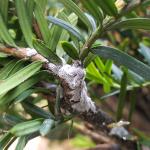 Taxus Mealybug: Dysmicoccus wistariae will produce honeydew and lead to sooty mold growth, yellowing of needles, and sparsely foliated plants. Eventual dieback may be possible. This species is commonly associated with taxus in New England, but can be occasionally found on dogwood, rhododendron, Prunus spp., maple, andromeda, and crabapple. These mealybugs are found on stems and branches and particularly like to congregate at branch crotches. Taxus mealybug feeds in the inner bark tissue of the trunk and branches. Adult females are present from June to August and give birth to living young in the summer. Immatures overwinter. A single generation may occur per year in New England, but areas to the south can have multiple generations of this insect. Management may be targeted between 246-618 GDD’s, base 50°F. Horticultural oil and neem oil may be used.
Taxus Mealybug: Dysmicoccus wistariae will produce honeydew and lead to sooty mold growth, yellowing of needles, and sparsely foliated plants. Eventual dieback may be possible. This species is commonly associated with taxus in New England, but can be occasionally found on dogwood, rhododendron, Prunus spp., maple, andromeda, and crabapple. These mealybugs are found on stems and branches and particularly like to congregate at branch crotches. Taxus mealybug feeds in the inner bark tissue of the trunk and branches. Adult females are present from June to August and give birth to living young in the summer. Immatures overwinter. A single generation may occur per year in New England, but areas to the south can have multiple generations of this insect. Management may be targeted between 246-618 GDD’s, base 50°F. Horticultural oil and neem oil may be used.- Twolined Chestnut Borer: Agrilus bilineatus is a native jewel beetle (also known as a flatheaded borer) in the Family Buprestidae. This insect is also in the same genus as the invasive emerald ash borer. The twolined chestnut borer is native to Massachusetts, much of New England, and the eastern United States. This species has one generation per year and adults are typically active from April – August, depending upon location and temperature. Adults will conduct some maturation feeding on oak prior to mating. Females will lay clusters of tiny eggs in the cracks and crevices of bark. Larvae hatch from the eggs in 1-2 weeks and burrow through the bark into the cambium, where they feed in a similar manner to the emerald ash borer, creating meandering galleries as they feed. (The galleries of the twolined chestnut borer can be straight in very stressed trees.) Larvae typically mature by August – October and burrow to the outer bark where they create a chamber in which they overwinter. Pupation occurs the following spring and adults emerge through D-shaped exit holes that are approximately 1/5 inch wide. In the northern extent of this insect’s range, they can take 2 years to complete their life cycle. Larvae of this insect have been recorded from eastern white oak, common post oak, burr oak, scarlet oak, northern red oak, and eastern black oak. Adults have been recorded on fir and pin oak. These insects are attracted to stressed host plants and typically become a secondary factor in the decline of the tree.
- Two-Spotted Spider Mite: Tetranychus urticae is a “warm-season” mite that loves hot and dry weather, which may favor the quick reproduction and build-up of this pest. Management should seek to preserve beneficial predatory mites. Monitor susceptible hosts (elm, maple, redbud, ash, black locust, tuliptree, and many deciduous shrubs) for increasing numbers of these mites until mid-August. Mites will be found on the undersides of leaves and cause stippling of the foliage.
- Viburnum Leaf Beetle: Pyrrhalta viburni is a beetle in the family Chrysomelidae that is native to Europe, but was found in Massachusetts in 2004. Viburnum leaf beetle overwinters as eggs laid in capped pits on the newest growth of susceptible viburnum branches. Scout for overwintered eggs and prune out and destroy before they hatch. Egg hatch occurs in late-April to early-May as temperatures warm and foliage becomes available. Monitor for larvae in mid-May (80-120 GDD’s). This beetle feeds exclusively on many different species of viburnum, which includes, but is not limited to, susceptible plants such as V. dentatum, V. nudum, V. opulus, V. propinquum, and V. rafinesquianum. Some viburnum have been observed to have varying levels of resistance to this insect, including but not limited to V. bodnantense, V. carlesii, V. davidii, V. plicatum, V. rhytidophyllum, V. setigerum, and V. sieboldii. More information about viburnum leaf beetle may be found at http://www.hort.cornell.edu/vlb/ .
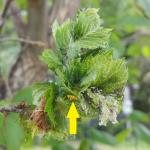 Woolly Apple Aphid: Eriosoma lanigerum may be found on apple, crabapple, hawthorn, mountain-ash, Pyracantha, and elm hosts. The primary (winter) host is elm, on which aphids infest emerging spring leaves, causing leaves to curl or close into stunted, rosette-like clusters found at twig tips. Woolly apple aphid was observed on elm on 6/1/2021 in Amherst, MA. Rosettes at this location are full of honeydew producing aphids. On apple and crabapple, this species of aphid colonizes roots, trunks, and branches in the summer and is commonly found near previous wounds or callous tissue. On roots, the aphids cause swelled areas which can girdle and kill roots. The aphids, when found in above ground plant parts such as elm leaves, are covered with white wax. Eggs are the overwintering stage on elm, which hatch in the spring in time for the nymphs to infest new elm foliage. Following a few generations on elm, the aphids will develop into a winged form, which will disperse and seek out apple and crabapple. Multiple generations will occur on these alternate hosts in the summer and by the fall, a winged form will return to elm and mated females will lay eggs near elm buds. These aphids are a favorite snack for insect predators such as the multicolored Asian lady beetle, Harmonia axyridis.
Woolly Apple Aphid: Eriosoma lanigerum may be found on apple, crabapple, hawthorn, mountain-ash, Pyracantha, and elm hosts. The primary (winter) host is elm, on which aphids infest emerging spring leaves, causing leaves to curl or close into stunted, rosette-like clusters found at twig tips. Woolly apple aphid was observed on elm on 6/1/2021 in Amherst, MA. Rosettes at this location are full of honeydew producing aphids. On apple and crabapple, this species of aphid colonizes roots, trunks, and branches in the summer and is commonly found near previous wounds or callous tissue. On roots, the aphids cause swelled areas which can girdle and kill roots. The aphids, when found in above ground plant parts such as elm leaves, are covered with white wax. Eggs are the overwintering stage on elm, which hatch in the spring in time for the nymphs to infest new elm foliage. Following a few generations on elm, the aphids will develop into a winged form, which will disperse and seek out apple and crabapple. Multiple generations will occur on these alternate hosts in the summer and by the fall, a winged form will return to elm and mated females will lay eggs near elm buds. These aphids are a favorite snack for insect predators such as the multicolored Asian lady beetle, Harmonia axyridis.
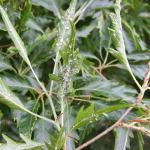 Woolly Beech (Leaf) Aphid: Phyllaphis fagi is a species of aphid commonly found on the leaf undersides of European beech, Fagus sylvatica, and its cultivars. This is a European species that is now widely distributed throughout North America. All life stages of this particular aphid occur on European beech foliage. European beech trees in North America have been observed as capable of holding large populations of this aphid year after year with little to no visible injury to the tree. Like their other aphid brethren, the woolly beech leaf aphid can create large quantities of sticky honeydew. These aphids were observed on Fagus sylvatica 'Asplenifolia' in Amherst, MA on 6/1/2021. The woolly beech leaf aphid is sometimes confused with another woolly aphid, also known as the beech blight aphid (Grylloprociphilus imbricator), which is only found on American beech, Fagus grandifolia. G. imbricator has an alternate common name, the boogie-woogie aphid, due to a behavior where this species, when colonies are disturbed, can wiggle (or dance) together, perhaps in an effort to distract potential predators.
Woolly Beech (Leaf) Aphid: Phyllaphis fagi is a species of aphid commonly found on the leaf undersides of European beech, Fagus sylvatica, and its cultivars. This is a European species that is now widely distributed throughout North America. All life stages of this particular aphid occur on European beech foliage. European beech trees in North America have been observed as capable of holding large populations of this aphid year after year with little to no visible injury to the tree. Like their other aphid brethren, the woolly beech leaf aphid can create large quantities of sticky honeydew. These aphids were observed on Fagus sylvatica 'Asplenifolia' in Amherst, MA on 6/1/2021. The woolly beech leaf aphid is sometimes confused with another woolly aphid, also known as the beech blight aphid (Grylloprociphilus imbricator), which is only found on American beech, Fagus grandifolia. G. imbricator has an alternate common name, the boogie-woogie aphid, due to a behavior where this species, when colonies are disturbed, can wiggle (or dance) together, perhaps in an effort to distract potential predators.
- Woolly Elm Aphid: Eriosoma americanum females lay a single egg in the cracks and crevices of elm bark, where the egg overwinters. Eggs hatch on elm in the spring as leaves are unfolding. Aphids may be active from 121-246 GDD’s, base 50°F on elm. A young, wingless female hatched from the egg feeds on the underside of leaf tissue. This female aphid matures and gives birth to 200 young, all females, without mating. These aphids feed, and the elm leaf curls around them and protects them. By the end of June, winged migrants mature and find serviceberry hosts. Another set of females is produced. These new females crawl to and begin feeding on the roots of serviceberry. Multiple generations occur on the roots of serviceberry through the summer.
Concerned that you may have found an invasive insect or suspicious damage caused by one? Need to report a pest sighting? If so, please visit the Massachusetts Introduced Pests Outreach Project: http://massnrc.org/pests/pestreports.htm .
Reported by Tawny Simisky, Extension Entomologist, UMass Extension Landscape, Nursery, & Urban Forestry Program
Weeds
Scout for annual weeds in ornamental beds. If a preemergence herbicide was applied earlier in the season now would be a good time to begin determining if the application provided effective control. Treat these weeds before they get too large. Spot spraying with a non-selective herbicide is usually a better strategy than hand-weeding because it does not break the mulch barrier.
Scout for weeds that may be creeping into beds from adjacent turf areas. Use a non-selective herbicide to edge the bed.
New growth expansion of poison ivy continues. Poison ivy is flowering so it should be treated now. Glyphosate or triclopyr are the best herbicides for poison ivy control and applications can be done from now until mid-September. Triclopyr products should be selected over glyphosate products in areas were grasses need to be saved. Contact (Scythe, Reward) or the non-chemical/organic herbicide products will provide “burndown” activity only and will not adequately control poison ivy.
Do not delay, treat garlic mustard, Alliaria petiolata, now. Plants have matured to a point where seedpods have formed and the seeds are not yet mature as they are still green. Garlic mustard is a biennial and herbicide applications at this time of year will control second-year plants before they go to seed as well as the first-year seedlings.
Many people are asking if glufosinate (Finale or Cheetah Pro) can be used as a replacement for glyphosate. Glufosinate and glyphosate are both non-selective, postemergence herbicides. Glufosinate is not translocated or only limitedly so, whereas glyphosate is strongly translocated. Translocation is the movement of an herbicide from the point where the herbicide application comes in contact with the leaves of a weed to other parts of the plant including the roots and/or rhizomes. The translocation of an herbicide is an important characteristic which determines whether an herbicide will control a perennial weed, especially if the weed reproduces vegetatively via creeping roots or rhizomes. Glufosinate does not provide good control of perennial weeds as it is not translocated. In summary, glufosinate is not a one-to-one replacement for glyphosate.
Many landscape trees commonly produce vegetative suckers at their trunk base. Suckers are commonly seen on crabapple, flowering cherry, flowering pear, plum, linden, maple and sometimes oak. Honeylocust commonly produces vegetative sprouts along the entire length of their trunk. If these suckers or sprouts are not controlled, the landscape will be a contender for the “Shabby Landscape Award”. Pruning is effective but very time consuming. Another option would be to use the product Scythe that contains pelargonic acid to remove these vegetative suckers and sprouts when they are very small. Very small means less than one inch in length. Pelargonic acid is a contact herbicide. If Scythe is applied to small suckers and sprouts, the product will desiccate them and physical removal will not be required. Larger growth will first need to be physically removed and then Scythe can be used as a maintenance program. Products that contain glyphosate should not be used as glyphosate is a translocated herbicide and injury to the whole tree is possible.
Do not attempt to control Japanese knotweed, Polygonum cuspidatum, currently as herbicide applications are not effective. In preparation for a late season herbicide application, cut or mow stands of knotweed to the ground in late May and early June. This practice is done to facilitate herbicide application by removing the dried stems from the previous year’s growth and will control plant height so knotweed will be shorter at the time of treatment in late summer. There is also some indication that the plant’s carbohydrate reserves may be reduced with this early season mowing.
A comment about the use of spray surfactants with herbicide applications. The rule is: “If an herbicide requires the addition of a surfactant, then one should be added per the label. If a surfactant is not required, then one should not be added”. If a required surfactant is not used, the efficacy of the herbicide can be significantly decreased to the point that the herbicide might not work. If a surfactant is added that is not needed, herbicide selectivity can be decreased, leading to with the possibility of injury or death of normally tolerant plants.
Report by Randy Prostak, Weed Specialist, UMass Extension Landscape, Nursery and Urban Forestry Program
Landscape Practices
Mulch 101
The Benefits of Mulching
Mulching is a common landscape practice for a reason; it can benefit plant and soil health along with providing aesthetic appeal. It is important to apply mulch appropriately, applying mulch no more than a 1-3” thick layer. Mulch over the root ball of plants should be minimal, only 1-2”, and mulch should not be touching stems or trunks.
Benefits of applying wood-product mulches:
· Reduces evaporation from the soil surface (increasing soil moisture)
· Increases soil organic matter as decomposition occurs thus improving soil structure and drainage as well as encouraging mycorrhizal activity
· Encourages beneficial soil organisms
· Suppresses weed growth (although weed seeds can blow in and germinate on the mulch surface)
· Reduces erosion
· Acts as an insulator, helping to moderate soil temperature, protecting plant roots
· Helps prevent mechanical damage from mowers and string trimmers that can occur when grass grows next to plants
It is generally best practice to avoid inorganic mulches. Stone and gravel can absorb or reflect heat which can damage plants and do not provide benefits to the soil like bark mulches. They can also make amending the soil difficult and can eventually sink down into the soil. Plastic mulches also don’t provide any benefits to the soil.
Avoiding Mulch Volcanoes
When it comes to mulch there is such a thing as too much of a good thing. Too frequently mulch is applied in excessive amounts, either directly around the base of plants or around landscape beds in general. “Mulch volcanoes”, which is mulch mounded around the base of plants, can have many negative impacts on plant health. When mounded around the base of plants, mulch can result in excessive moisture leading to decay along with predisposition to insect and disease problems. Secondary root formation can also occur, which is the formation of roots above the trunk flare in the mulch areas. These roots often circle the trunk, gradually girdling the tree if not carefully removed. When mulch is applied too thickly throughout the landscape bed it can have contrasting negative impacts on water movement through the mulch and to the soil. In some cases, the thick mulch absorbs and holds the water, preventing it from infiltrating to the soil and leaving it unavailable for plant uptake. Other times, the water does infiltrate to the soil but the thick mulch layer prevents evaporation from occurring, leading to the soil staying too wet leading to rot problems and reduced oxygen in the soil.
Potential Problems
Sour mulch and fungi can be unpleasant problems resulting from wood-product mulch applications. Sour mulch is a problem that occurs during production and is the result of mulch being piled too high. In very large piles compaction and heating can occur at the base of the pile, resulting in anaerobic conditions and the buildup of organic acids which can lower the pH of the mulch. When sour mulch is applied in the landscape it can lead to the rapid decline of plant material and a foul smell. If sour mulch is unknowingly applied to the landscape, spreading the mulch thin and watering heavily can leach the toxins. Sour mulch should also be moved away from plants to avoid damage. It is important when developing mulch or wood chip piles to make sure they are not piled higher than 10’.
Fungi such as slime molds, bird’s nest fungi, artillery fungus, stinkhorns, and mushrooms are often found in mulches. These fungi are associated with mulches because of the decomposition of the mulch. In general, these fungi are not harmful to plants, and are not associated with health hazards unless consumed. Most of these fungi are just visual nuisances. Artillery fungus however can be a problem as expelled spore masses can stick to homes and vehicles, and are difficult to remove. When removed they can leave a stain. These fungi are most prevalent with moist rotting mulch especially in cool northern facing locations. Disturbing the mulch in areas that are conducive to artillery fungus can help dry out the area and make it less ideal for the fungus. Replacing mulch and freshening mulch can also help.
Sources:
Kujawski, R. and D. Swanson. 2011. Sour Mulch. UMass Extension.
Pettinelli, D. Mulch Basics. University of Connecticut.
Smith, T. 2011. Fungi in Mulches and Composts. UMass Extension.
The Morton Arboretum. Mulching trees and shrubs.
Report by Mandy Bayer, Extension Assistant Professor of Sustainable Landscape Horticulture, UMass Stockbridge School of Agriculture
Additional Resources
Pesticide License Exams - The MA Dept. of Agricultural Resources (MDAR) is now holding exams online. For more information and how to register, go to: https://www.mass.gov/pesticide-examination-and-licensing.
To receive immediate notification when the next Landscape Message update is posted, join our e-mail list or follow us on Facebook.
For a complete listing of upcoming events, see our upcoming educational events https://ag.umass.edu/landscape/upcoming-events
For commercial growers of greenhouse crops and flowers - Check out UMass Extension's Greenhouse Update website
For professional turf managers - Check out Turf Management Updates
For home gardeners and garden retailers - Check out our home lawn and garden resources.
Diagnostic Services
UMass Laboratory Diagnoses Landscape and Turf Problems - The UMass Extension Plant Diagnostic Lab is available to serve commercial landscape contractors, turf managers, arborists, nurseries and other green industry professionals. It provides woody plant and turf disease analysis, woody plant and turf insect identification, turfgrass identification, weed identification, and offers a report of pest management strategies that are research based, economically sound and environmentally appropriate for the situation. Accurate diagnosis for a turf or landscape problem can often eliminate or reduce the need for pesticide use. For sampling procedures, detailed submission instructions and a list of fees, see Plant Diagnostic Laboratory
Soil and Plant Nutrient Testing - The University of Massachusetts Soil and Plant Nutrient Testing Laboratory is located on the campus of The University of Massachusetts at Amherst. Testing services are available to all. The lab provides test results and recommendations that lead to the wise and economical use of soils and soil amendments. For more information, visit the UMass Soil and Plant Nutrient Testing Laboratory web site. Routine soil analysis and particle size analysis ONLY (no other types of soil analyses available at this time). Turnaround time: Please plan for the fact that date of receipt in the lab is affected by weekends, holidays, shipping time, and time for UMass Campus Mail to deliver samples to the lab. Campus Mail delivery only takes place on Monday, Wednesday, and Friday due to pandemic restrictions.
Tick Testing - The UMass Center for Agriculture, Food, and the Environment provides a list of potential tick identification and testing options at: https://ag.umass.edu/resources/tick-testing-resources.
